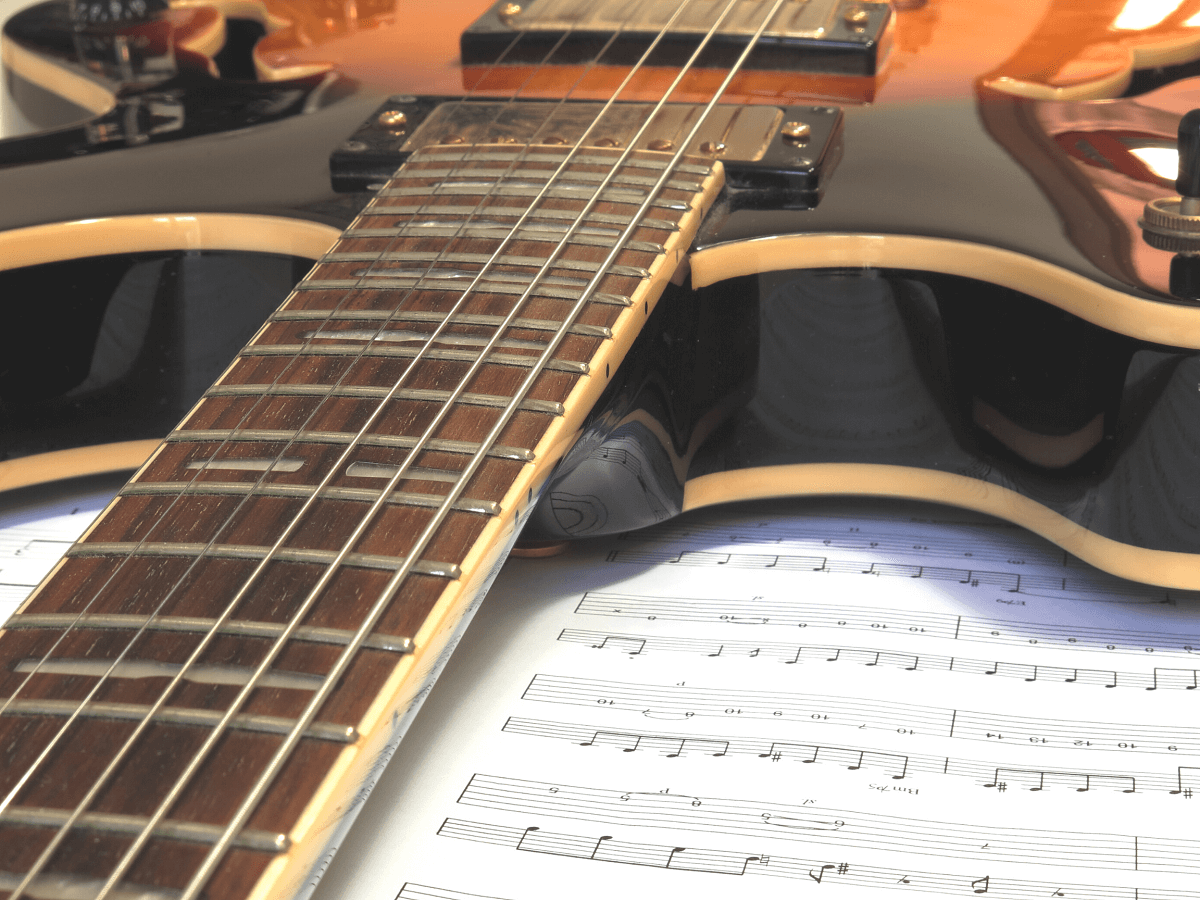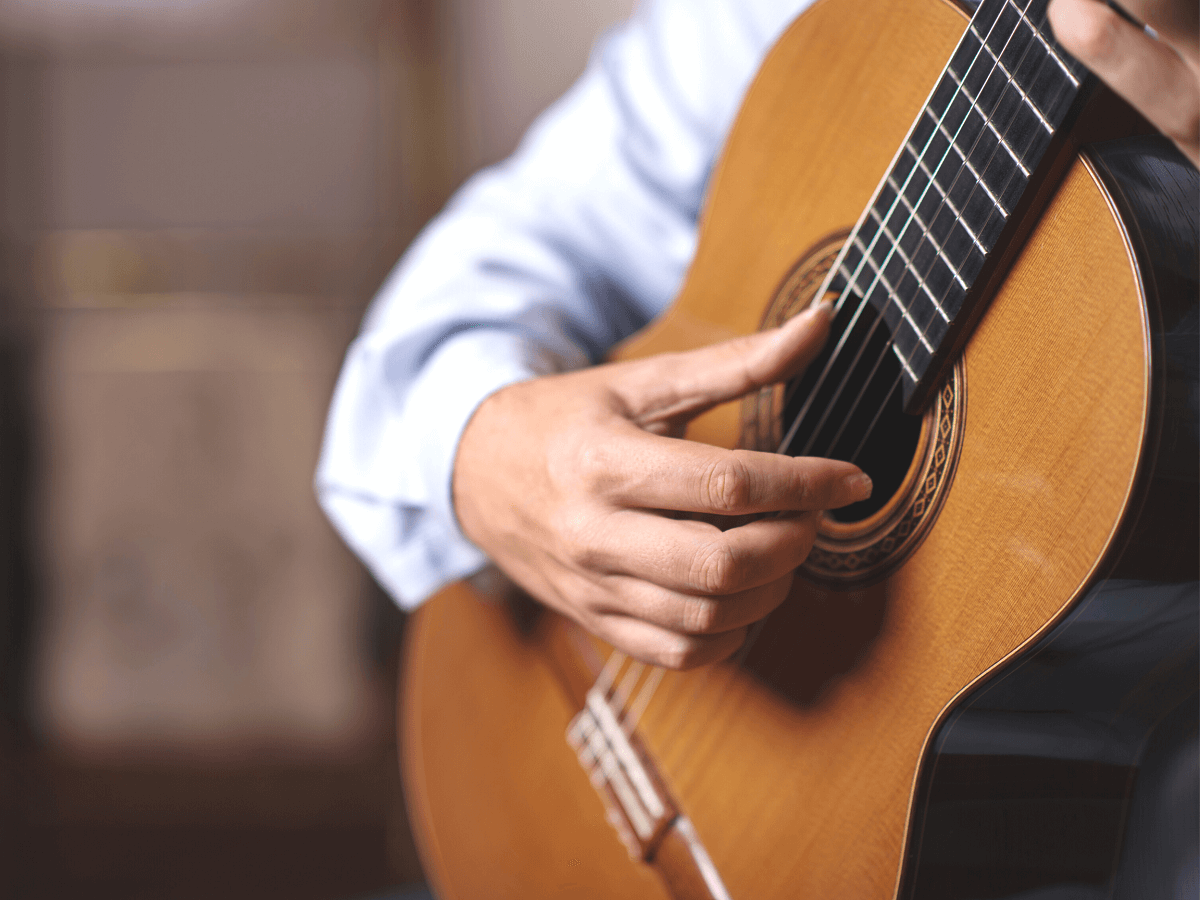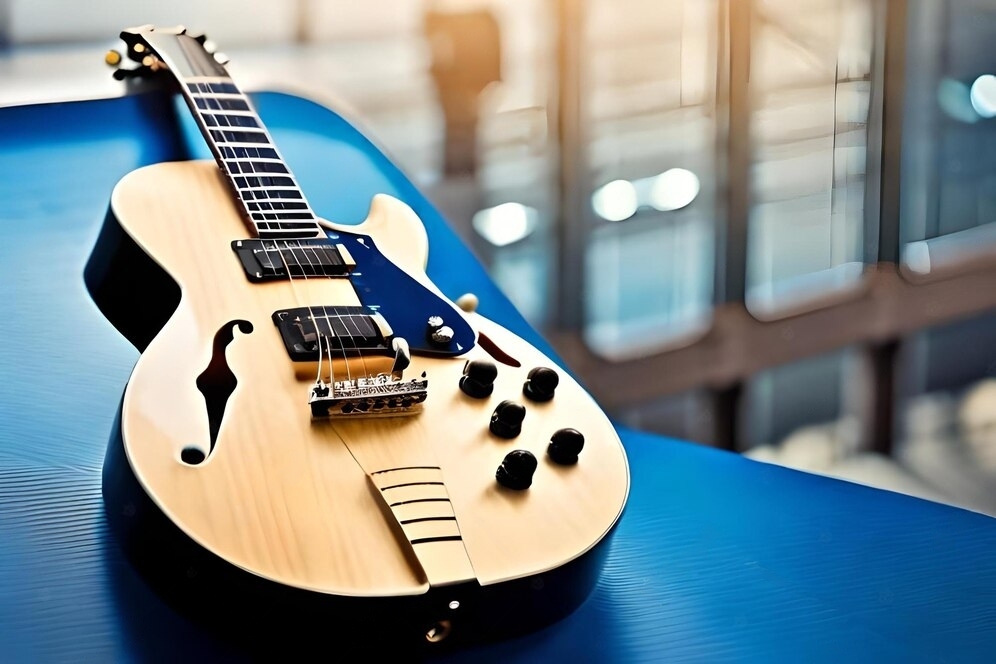Guitar selection plays a pivotal role in the overall sound and aura that singer-songwriters produce.
In the vast and varied music industry, acoustic guitars hold a special place due to their intrinsic warmth and a more personal touch.
Whether you’re a seasoned performer or just beginning to articulate your musical visions, having the right guitar can significantly influence your creative output.
Being aware of the key factors, including sound, playability, craftsmanship, and value, is essential when investing in an acoustic guitar.
Identifying the perfect guitar is not about brand loyalty or aesthetics, it’s about finding a tool that enhances your unique voice and complements your musical style.
In the following segments, we present an analysis and comparison of the top acoustic guitars available in the market, specifically curated for singer-songwriters.
Table of Contents
- Best Acoustic Guitars For Singer-songwriters
- Seagull S6 Original Acoustic Guitar
- Cordoba C5-CE Iberia Series Acoustic-Electric Guitar
- Martin D-28 Acoustic Guitar
- Washburn WD7S Dreadnought Acoustic Guitar
- Blueridge BR-160 Historic Series Acoustic Guitar
- PRS SE Parlor P20E Acoustic-Electric Guitar
- Larrivee OM-40 Legacy Acoustic Guitar
- Jasmine S-34C Cutaway Acoustic Guitar
- Fender Malibu Player Acoustic Guitar
- Martin LX1E Little Martin Acoustic-Electric Guitar
- Taylor 814ce Acoustic-Electric Guitar
- Fender CD-60S All-Mahogany Dreadnought Acoustic Guitar
- Epiphone Slash J45 Acoustic-Electric Guitar
- YAMAHA FG800 Solid Top Acoustic Guitar
- Epiphone DR-100 Acoustic Guitar
- What to Look for When Buying Acoustic Guitars?
- How Important is the Type of Wood in an Acoustic Guitar?
- What is the Significance of Body Shape in Acoustic Guitars?
- How Does String Material Impact the Sound of an Acoustic Guitar?
- Which Brands Are Known for Quality Acoustic Guitars?
- How Do You Care for an Acoustic Guitar?
- What Are the Pros and Cons of a Cutaway Design?
- Should You Consider an Acoustic Electric Guitar?
- How to Resolve Common Acoustic Guitar Issues?
- What Skills Are Important for Playing Acoustic Guitar?
- The Bottom Line
Best Acoustic Guitars For Singer-songwriters
Before I begin, here are my top selected choices:
|
|
Seagull S6 Original Acoustic Guitar

Handcrafted North American guitar with superior intonation. Check Price
|
Seagull S6 Original Acoustic Guitar

Handcrafted North American guitar with superior intonation.
Check Price
|
Seagull S6 Original Acoustic Guitar
Handcrafted North American guitar with superior intonation.
Manufactured in North America, this acoustic guitar combines the warmth of mahogany and the clear definition of maple with its wild cherry back and sides. It features a solid cedar top and rosewood fretboard, providing comfortable play with its shorter 24.84″ scale. Offering dependable tuning with specially designed machine heads, it also includes a Tusq nut and compensated saddle for improved intonation.
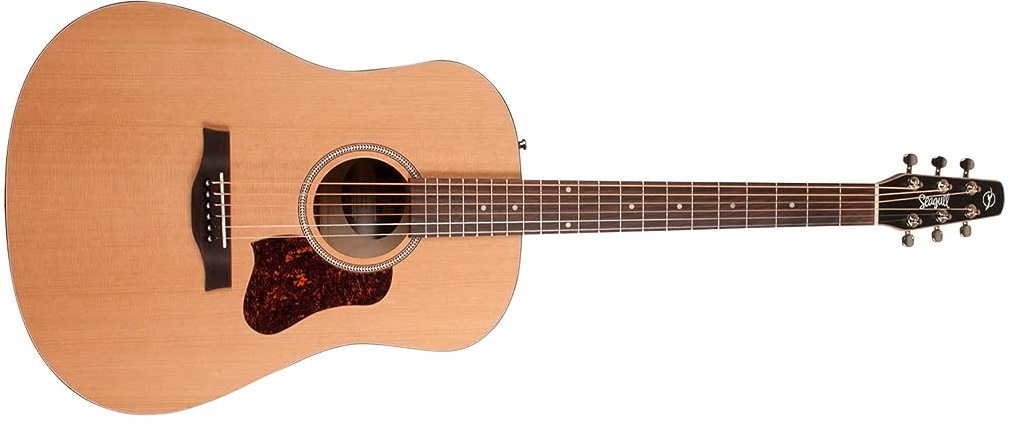
This acoustic guitar, the Seagull S6 Original, is a proud North American creation.
Notably, it has a Select Pressure Tested Top, ensuring the quality of its sound.
One of its unique features is the Double Action Truss Rod, which enhances the guitar’s sound profile.
Additionally, the Tapered Headstock allows for precise tuning, particularly suitable for open tunings.
Optimal intonation is achieved with the Tusq nut and compensated saddle.
Identifying the materials used in manufacturing, its top is made of cedar, whilst the body is a blend of cedar and wild cherry.
The back material is also cherry, whereas the neck is constituted of maple.
A rosewood fretboard, along with a guitar bridge system, puts a premium on user comfort.
This guitar is designed for right-hand orientation and uses Phosphor Bronze strings.
Describing its aesthetic appeal, the use of domestic wild cherry for the back and sides gives it a distinctive tone.
This tone combines the warmth of mahogany and the crispness of maple, making it unique in the Seagull S6 series.
The shorter scale of its silverleaf maple neck, combined with a rosewood fretboard, ensures playing ease.
Plus, the specially aligned machine heads offer quick, stable tuning.
Lastly, this guitar exhibits a semi-gloss lacquer finish, enhancing its visual attractiveness.
- My Review
What really stands out about the Seagull S6 Original Acoustic Guitar is its solid craftsmanship and unique design.
As I played this instrument, I was struck by the truly beautiful tone it produces, easily the best in its price range.
I found it to be a strikingly comfortable and easy to handle guitar, especially while seated.
One highlight of the guitar is the exceptionally wide fingerboard, although, those with smaller hands might want to consider the Slim version.
As I strummed away, I was impressed by its bright, clear mid-range and rich bass tones, made all the more enjoyable by the fresh, high-quality strings with which it was shipped.
However, I noticed that the Seagull S6, which features a nut width of 1.72, is in fact an S6 Slim and not an S6 Original with a nut width of 1.8. But, for those who prefer a wider fingerboard like myself, the slim version might pose a challenge.
Playing this guitar, I also noticed that its sound quality sometimes becomes dull in certain weather conditions, and it requires more frequent tuning.
I also discovered that the Seagull’s finish can be easily scratched, which came as a bit of a surprise and disappointment.
I cannot help expressing my disappointment when this beautiful instrument arrived without a pickguard.
However, this omission did not mar my enjoyment of its overall aesthetics and superb performance.
When it came to adjusting the action and truss rod, I found it quite simple, thanks to the inclusion of a long-reach hex wrench.
Checking the measurements on the guitar, I noticed that in terms of workmanship, there seems to have been a lack of attention to detail.
For instance, the stain on the fret started peeling off, showing two different colors, which is not what one expects from a guitar in this price range.
I feel that this is a flaw that could be rectified by the manufacturer to improve the overall quality of the product.
Despite these drawbacks, I personally believe the value and quality of the Seagull S6 outweigh these minor issues.
I would say the Seagull S6 Original Acoustic Guitar provides a lot of bang for your buck, despite certain shortcomings.
- Pros:
- Great sound and playability.
- Beautiful craftsmanship.
- High-quality build materials.
- Cons:
- Inconsistent sound quality.
- Frequent tuning required.
- Slim version mislabelling.
My final verdict is that the Seagull S6 Original Acoustic Guitar is outstanding in quality and craftsmanship.
The guitar’s unique tone, thanks to the wild cherry back and sides, offers a remarkable blend of mahogany’s warmth and maple’s crisp definition.
The shorter 24.84″ scale with a rosewood fretboard makes it easy on the fingers, enhancing the playing experience.
The stability in tuning provided by the well-designed machine heads and the precise intonation due to the Tusq nut and compensated saddle, makes it an excellent purchase.
For those in search of a guitar made with North American craftsmanship and unique tonal characteristics, look no further than the Seagull S6 Original Acoustic Guitar.
Cordoba C5-CE Iberia Series Acoustic-Electric Guitar
Quality Acoustic Electric Guitar with Onboard Tuner
The Cordoba C5-CE Iberia Series Guitar sports a solid cedar top, a mahogany back, sides, and neck, along with a rosewood bridge and fingerboard. It’s designed for right-handed players, uses nylon strings and features a Fishman Isys Plus pickup. The natural-colored acoustic/electric nylon string guitar comes with a gig bag, has a scale length of 25.6 inches, and a nut width of 1.96 inches.
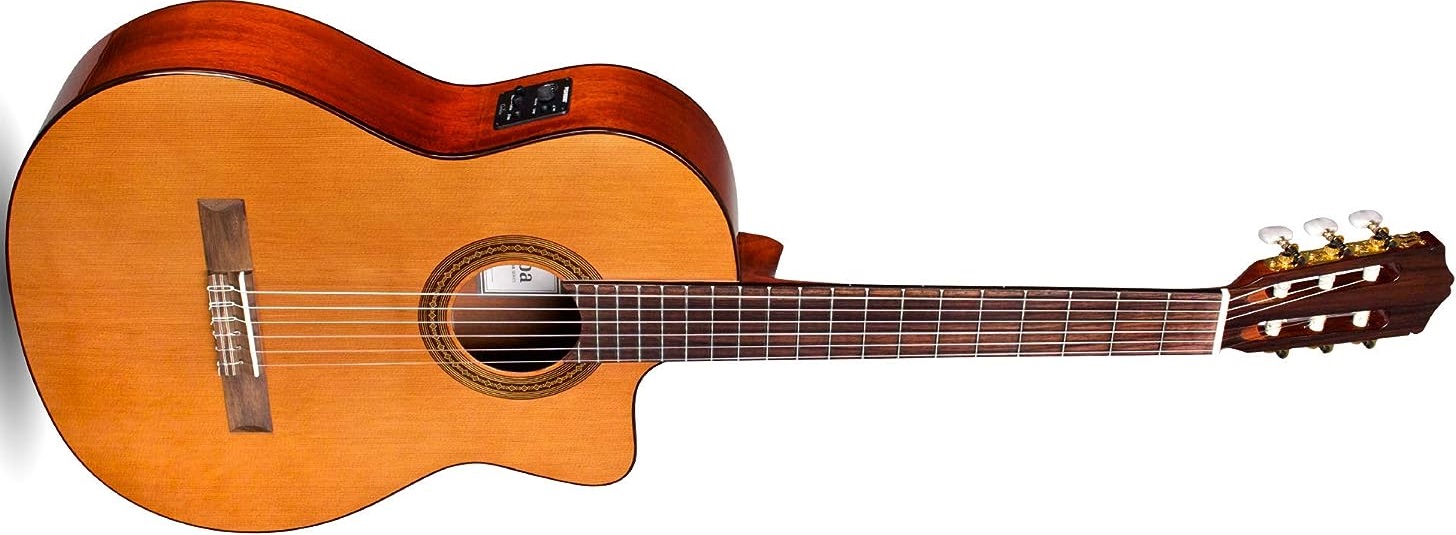
The Cordoba C5-CE Iberia Series is not your average guitar. It’s an acoustic electric type with a unique classical touch.
Constructed with a solid Cedar top, this guitar offers a rich and resonant sound.
The body of this guitar is made up of Mahogany, as is the back and sides, which also features a soft cutaway.
Adding to its premium design, it also boasts a Rosewood bridge and fingerboard, offering smooth playability and enhanced aesthetic appeal.
What sets this guitar apart is the inclusion of a Fishman Isys Plus Pickup, offering excellent signal transmission and enhanced sound quality.
Branding is no issue with this guitar. This is a well-crafted piece by the renowned company, Cordoba.
Its natural color and wood materials lend it an authentic and classy look that many musicians appreciate.
Specs-wise, it features a string type of Nylon, and is designed for right-hand usage.
As an added bonus, this guitar also includes a gig bag and an onboard tuner, perfect for musicians on the go.
It has a scale length of 650mm (25.6 inches) and a nut width of 50mm (1.96 inches), providing comfortable playability for any musician.
- My Review
I recently had the chance to experience the Cordoba C5-CE Iberia Series Acoustic Electric Classical Guitar firsthand.
I was initially taken aback by the guitar’s impressive craftsmanship and the beautiful combination of a solid Cedar top along with Mahogany back and sides.
The guitar’s body was lovingly crafted from wood, providing it with a genuine, organic feel, both visually and acoustically.
My fingers glided on a Rosewood bridge and fingerboard, which added to the tactile enjoyment of playing this instrument.
Moreover, it delivers a splendid sound, both acoustically and electrically via the Fishman Isys Plus Pickup.
Considering its design, it is ideally suited for right-handed players with nylon strings providing a distinctive tonal character.
The instrument initially came as a disappointment, an internal component – the wiring of the pickup system was unsecured.
The swinging wires inside the guitar body created an annoyance while playing, however, post this initial hiccup, the acoustic sound was nothing short of delightful.
Comparing it with other guitars, I found the play to be distinct, the string action can be considered a bit taut.
While some may view this as a negative, it does allow for a different approach and playing style.
The sound, albeit not as bright as some competitors, has a warm, tight sound that is quite pleasing.
I did, however, encounter an issue with the battery box leading to a loud buzzing noise.
The battery box door’s poor design resulted in it being loose, responding to certain frequencies with a distracting noise.
The battery box self-destruction can happen with time as a result of a battery removal, leading to permanent damage.
With consistent play, I noticed some buzzing from the strings and attributed this to a problem with the guitar’s setup.
I had to raise strings and tape down all electronics in the body of the guitar to rectify this issue.
Despite the issues encountered, I feel the quality of sound is quite satisfying given the price range of the guitar.
The guitar arrived with a beautiful natural color finish and was indeed a treat to the eyes.
While it might not be the ideal choice for a beginner, for someone with a bit more experience and the willingness to deal with minor setup issues, this guitar can indeed bring a lot of musical joy.
- Pros:
- Excellent sound quality.
- Durable construction.
- Includes Cordoba gig bag.
- Cons:
- Potential for loose internal wires.
- Batteries box poorly designed.
- Included strings may snap.
My final verdict is that the Cordoba C5-CE Iberia Series Acoustic Electric Classical Guitar offers fantastic value for its price point.
With a Solid Cedar top and a Mahogany back, the quality of the materials used to construct this guitar is outstanding, allowing it to produce rich and durable sound.
The addition of a convenient Fishman Isys Plus Pickup makes it perfect for both practice and performance, offering versatility for all types of players.
I strongly recommend this guitar for both beginners and experienced players looking for a high-quality, multi-purpose instrument.
Martin D-28 Acoustic Guitar
Vintage design meets modern improvements in acoustic guitar.
The Martin 2017 D-28 combines historical guitar details with modern enhancements. It includes vintage appointments, a special neck profile, and forward-shifted bracing for better top vibration. This re-envisioned classic results in a unique blend of traditional craftsmanship and contemporary design.
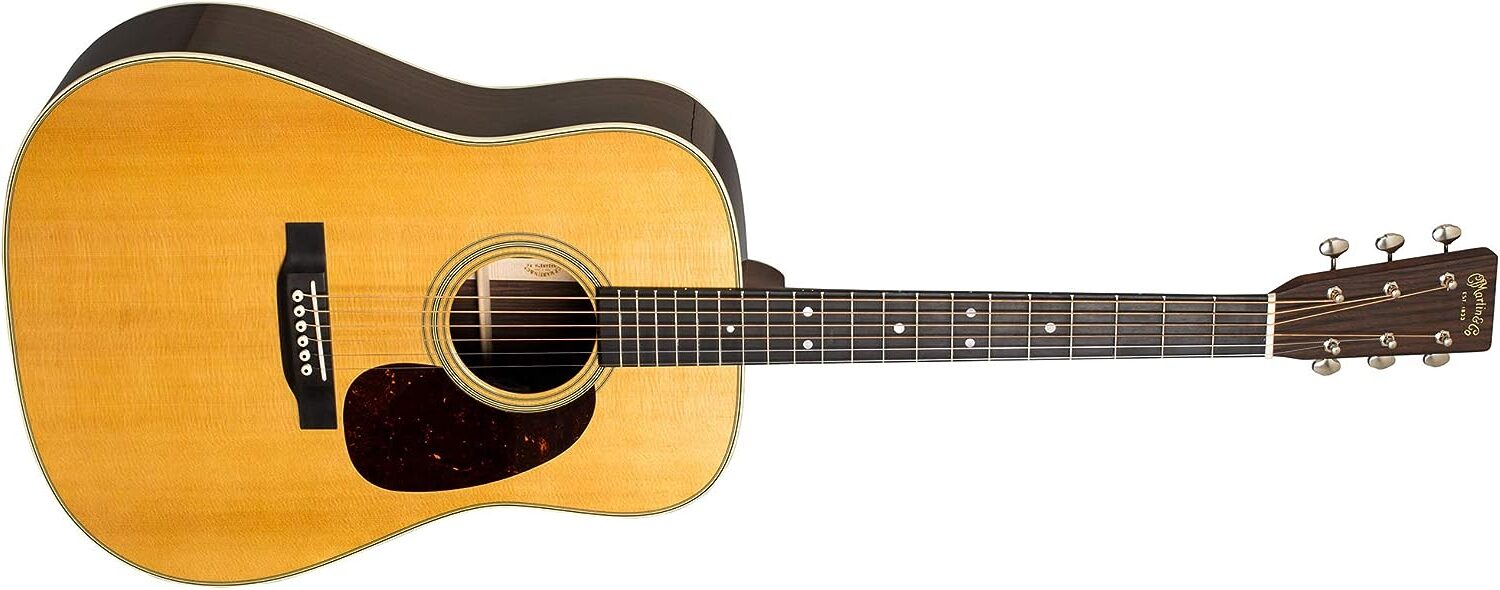
Martin’s D-28 Dreadnought Acoustic Guitar dons a simplistic yet striking appearance in a natural colorway.
It boasts of antique white binding and noticeable style 28 mother-of-pearl fingerboard inlays, complementing its solid headstock that incorporates a sharp square taper and glimmering diamond inlay.
Aligned for right-handed use, it is crafted using spruce wood for the top and rosewood for both the body and fretboard.
It is obvious that Martin introduced numerous enhancements to this iconic instrument, which was a popular choice among many legendary musicians like Hank Williams, The Beatles, and Bob Dylan.
Interestingly, Chris Martin, the firm’s chairman, reveals they incorporated the optimal features of the post-WWII D-28, which was distinguished by subtle differences from its forerunner and became an emblematic symbol of the folk rock movements of the 50s and 60s.
They have ensured that the modified D-28 bestows a modern feel, facilitating a comfortable playing experience while it retains its rich heritage.
Notably, the guitar incorporates tweaks such as forward-shifted bracing to amplify the vibration of the top, antique white accents, and a faux tortoise pickguard.
Moreover, it makes use of SP Acoustic 92/8 Phosphor Bronze Medium strings and flaunts multi-stripe top and back inlays.
Lastly, in line with its legacy, the brand continues to offer signature strings, folk and Darco strings, and a variety of guitar care accessories for its patrons.
- My Review
Immersing myself into the music with the Martin D-28 Dreadnought Acoustic Guitar, I was awestruck by the richness and depth of its sound.
Distinguished by its superb solid headstock, square taper and diamond inlay, this guitar flaunts perfection in terms of design.
Further enhancing the beautiful craftsmanship is the STYLE 28 mother-of-pearl fingerboard which added a touch of opulence.
Featuring antique white binding with aging toner, the guitar boasts a grandeur that’s hard to ignore.
The quality of the sound is strongly influenced by the non-scalloped X bracing, which produces an impeccable resonance and tone.
Bearing in mind the comfort of musicians, this instrument embraces a dovetail neck joint that promises smooth playability.
Each strum on the strings, which are made of 92/8 phosphor bronze medium, seems to breathe life into the music.
Adorned with multi-stripe top and back inlays, this dreadnought guitar screams style and elegance.
As I played it, each chord I struck resonated with a warmth that can only come from rosewood body and spruce wood top material.
Aesthetically, this Martin guitar sports a natural color, and encapsulates a timeless beauty in its simplicity.
One can undoubtedly perceive the superior craftsmanship that went into producing a neck made of rosewood fretboard and mahogany material type.
It should be noticed that this guitar is designed for right-hand orientation and consists of six strings.
Listening to the sound of this guitar, it’s clear that its purpose is to empower the musician with a robust and powerful tone.
Digging deeper into the persona of this guitar, one would uncover that the classic, and quality construction pays tribute to the history of the brand, yet it boasts an innovation that keeps it relevant and appealing.
The authenticity of acoustic strings is evident in the pure and refined sound produced.
One could say that this guitar truly exemplifies the perfect blend of tradition and modernity.
For those who are serious about their music and demand nothing less than perfection, this guitar is a match made in heaven.
Playing this guitar is like embarking on a musical journey, where each strum is a step towards an unforgettable experience.
The Martin D-28 Dreadnought Acoustic Guitar is not only an instrument, but it is a piece of beauty and craftsmanship to be appreciated by both the musician and the audience.
- Pros:
- Top-notch sound quality.
- Comfortable and easy to play.
- Retro yet modern, stylish design.
- Cons:
- Expensive for the beginner.
- May be big for smaller players.
My final verdict is that the Martin 2017 D-28 Dreadnought Acoustic Guitar Natural is a masterpiece built on the rich heritage of Martin’s legendary D-28 and updated with innovative features for the modern musician.
It combines vintage appointments with a modern feel, every part and feature does not only enhance the esthetics but also the functionality, making it truly a workhorse for any music enthusiast.
Apart from the unique fusion of the old and the new, the quality of craftmanship is unparalleled, making the guitar not just an instrument but a piece of legacy passed down by generations of Martin.
The sound that this guitar produces is rather exceptional, it is bold, distinctive and resonates beautifully.
I would highly recommend the Martin 2017 D-28 Dreadnought Acoustic Guitar Natural, to both professionals and budding artists who appreciate quality, innovation, and history in their music.
Washburn WD7S Dreadnought Acoustic Guitar
Quality, affordable acoustic guitar with superior sound.
This acoustic guitar consists of a solid spruce top with mahogany sides and back, available in both gloss and matte finishes. It features a dreadnought body style, specifically designed for live performances. Known for superior quality and innovation, the Washburn brand guarantees high-quality sound and durability.
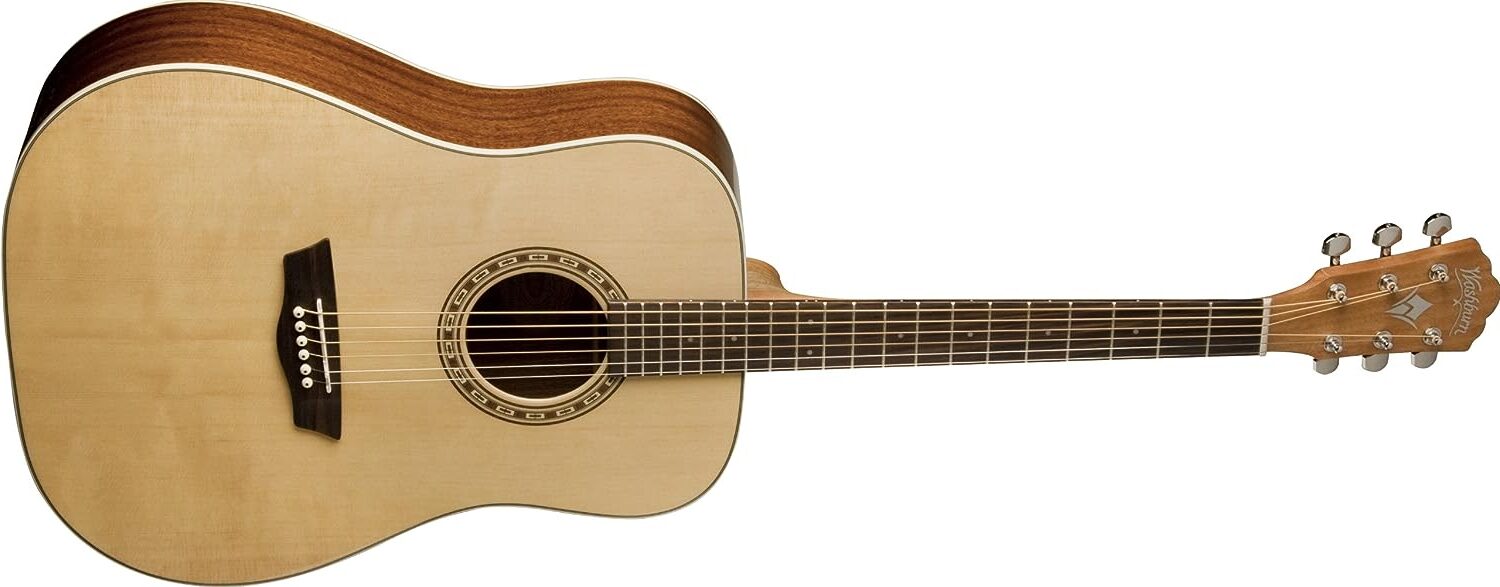
The Washburn WD7S Harvest Series stands out due to its strong, durable build and superior tones, primarily attributed to the Solid Sitka Spruce and Mahogany utilized in its construction.
Exhibiting a dreadnought body style, this guitar comes with a solid Spruce top which significantly contributes to its rich and unique resonance.
The Mahogany sides and back of the guitar add to the overall durability while enhancing the depth of sound, making it an ideal choice for professional gigs and live performances.
The finish of this guitar is available in gloss or matte, thus providing options to suit individual preferences.
This guitar, manufactured by the eminent brand, Washburn, has an astounding heritage of high-quality craftsmanship spanning many generations in the music industry.
The top material of this guitar is spruce, renowned for its responsive acoustic qualities, while the body comprises Mahogany and Spruce to offer robust build and fine tones.
Even the neck and fretboard are crafted from Mahogany and Rosewood respectively, reflecting the detail-oriented craftsmanship and precise attention to materials.
The Washburn WD7S is designed for right-hand orientation and comes with six strings, ideal for strumming a broad spectrum of musical genres.
Moreover, Washburn’s Harvest series guitars flaunt a non-glare satin finish, making them aesthetic and performance friendly.
An offering from Washburn epitomizes quality, durability, and innovation making this brand well-esteemed in the guitar realm.
- My Review
It was indeed a pleasure to play the Washburn WD7S Harvest Series Acoustic Guitar.
Adorning a delightful hue of natural gloss, this instrument boasts a robust dreadnought body style that is a sight for sore eyes.
The solid spruce top visually complements the rich mahogany sides and back, making this piece not only an acoustic delight but an aesthetic one as well.
However, while the exterior is quite striking, it’s the superior sound quality of the Washburn acoustic guitar that truly mesmerized me.
The combination of spruce and mahogany materials culminate into a high-quality acoustic sound that is quite remarkable for a guitar in this price range.
Whether strumming chords for a soulful melody or plucking notes for a foot-tapping tune, the rich, smooth, and balanced tone emanating from the guitar was a constant source of joy.
Moreover, the right-hand orientation and comprehensive six-string setup worked brilliantly together, affirming the fact that Washburn has indeed mastered the art of guitar design.
However, this is not to say that the guitar was without its shortcomings.
The tuning heads, for instance, left a bit to be desired as they were a bit flimsy, making tuning the guitar somewhat of a challenge.
Yet, as I got more comfortable with the instrument, I somewhat managed to overcome this hurdle and the guitar seemed to hold its tune well once set.
With all the fine attributes of the Washburn acoustic guitar, it’s safe to say that this instrument would be an ideal fit for not just a seasoned player, but a beginner as well.
Its sturdy and hand-friendly fretboard facilitates easy navigation, while the responsive strings offer an enjoyable playing experience.
Moreover, this guitar’s robust construction promises great durability, assuring that it can endure heavy-handed strumming and long-term use while remaining intact.
I must say that the Washburn WD7S Harvest Series guitar is indeed a fascinating instrument, renowned for its seamless fusion of design, craftsmanship, and performance.
It’s a guitar that offers much more than what its price tag suggests, making it a valuable addition to any musician’s collection.
- Pros:
- Exceptionally good tone and quality.
- Low action with no buzzing.
- Great for beginners and intermediate players.
- Cons:
- Poor quality tuning heads.
- No included case.
- Some may prefer different finish types.
My final verdict is that the Washburn WD7S Harvest Series Solid Sitka Spruce/Mahogany Dreadnought Acoustic Guitar is an excellent quality product that justifies its price tag.
This instrument offers top-notch craftsmanship, an impressive blend of materials, and a natural gloss finish that is both aesthetically pleasing and functional.
Not only is it ideal for live performances due to its stage-ready cut away feature, but the quality of sound it produces is unmatched in its price range.
This innovative guitar would be an excellent choice for both aspiring and experienced musicians.
Investing in a Washburn product ensures not just a musical instrument, but a piece of musical history.
Blueridge BR-160 Historic Series Acoustic Guitar
Superior sound, vintage look and smooth playability.
Constructed from solid Sitka spruce with scalloped braces, the guitar provides clean articulation and a crisp tone, with a strong bass due to the Indian rosewood back. It features a slim mahogany neck with a smooth East Indian rosewood fingerboard for easy playability. It comes with a unique tortoise style pickguard, adding to its vintage appeal.
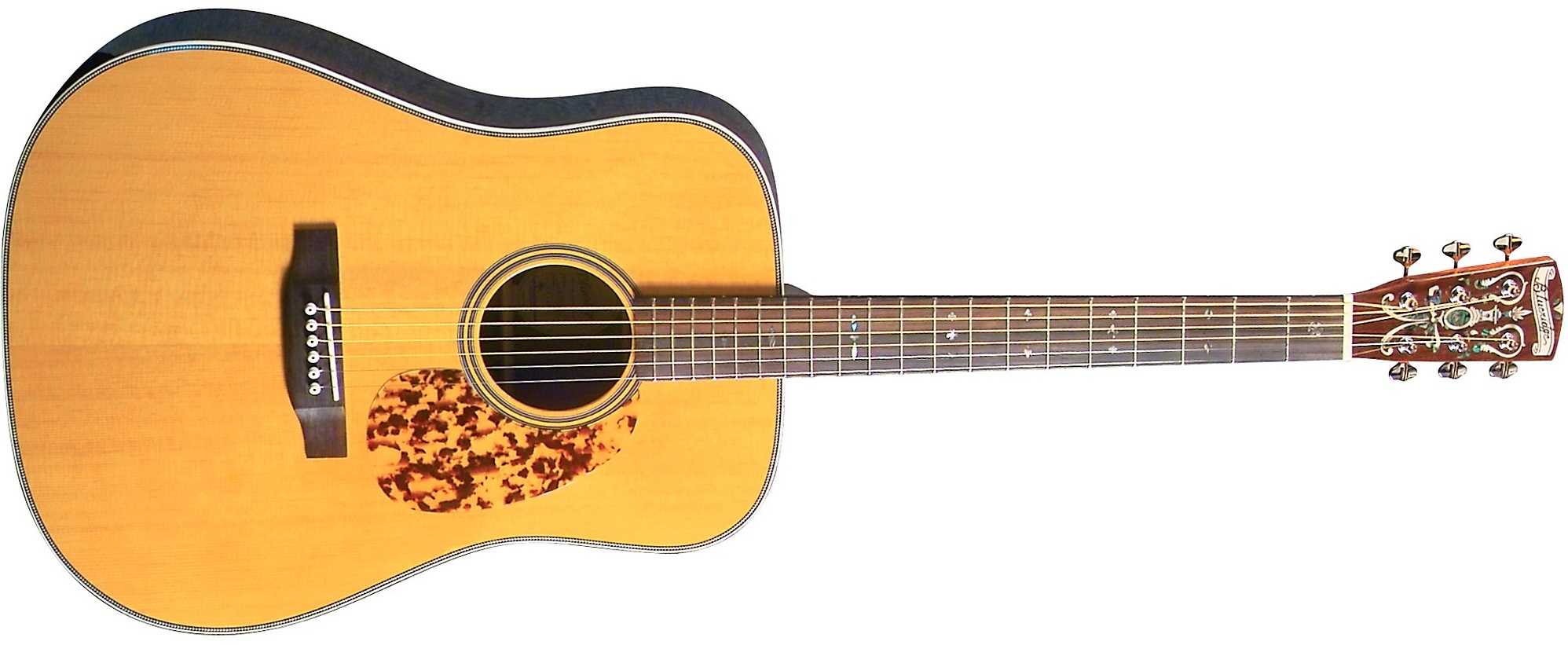
With its title as the Blueridge BR-160 Historic Series Dreadnought Guitar, the music instrument prides itself on its superior features.
It boasts a solid Sitka spruce top with scalloped braces, ensuring a well defined and, more importantly, clear tone.
The outstanding solid Indian rosewood incorporated in the back and sides guarantees that you get rich bass and excellent cutting power.
The slim mahogany neck doesn’t just offer a quick easy action, it also brings intrinsic stability that promise longevity.
Moreover, the handpicked East Indian rosewood used for the fingerboard ensures that you get a silky smooth playability.
For lovers of vintage designs, its distinctive tortoise style pickguard recreates a captivating 30’s vintage look.
As stated in its specifications, The guitar falls under the Blueridge Guitars brand, is yellow in color and specially designed for right-handed musicians.
The materials used in its construction include: Spruce Wood for the top, Spruce and East India Rosewood for the body, while ,Rosewood backs it up and a Mahogany neck.
As described, this dreadnought resonates a strong full sound thanks to its solid Sitka spruce top and hand-carved parabolic top braces that align with the prewar forward x-pattern.
The BR-160, owing to its great sound and aesthetic appeal, is touted as one of the most desirable vintage style acoustic guitars currently in production.
- My Review
Based on my experience with the Blueridge BR-160 Historic Series Dreadnought Guitar, I can confidently say this guitar offers a array of features to enhance your playing experience.
Solid Sitka spruce top adorned with scalloped braces not only provides a captivating appearance, but also delivers a clean articulation and a crips tone.
The Indian rosewood back and sides assure a deep bass and strong cutting power, perfect for those who enjoy a robust sound.
In my hands, the slim mahogany neck was supremely comfortable, offering quick, effortless action and impressive, innately enduring stability.
Fingertips glide over the East Indian rosewood fingerboard making every playing session a smooth and enjoyable experience.
What caught my attention in particular was the tortoise-style pickguard adding a perfect touch of vintage aesthetics.
The guitar arrives in a pleasing shade of yellow, giving it a classic, timeless appeal.
Also, the phosphor bronze strings are a great inclusion, offering a rich, warm tone that is simply irresistible to the ears.
Being a right-handed guitar, it fits perfectly in my grip and the Rosewood guitar bridge system further ensures an easy playability.
The guitar’s tone and sustain left me absolutely impressed, and I found it to be one of the best I have come across in a long time.
Now, let’s talk about the build quality-Solid Indian Rosewood and Spruce top are the materials of choice for the body, offering both durability and beautiful sound.
While the guitar is stunning and sounds amazing, it was noticeably missing the strap button on the heel- a vital component for those who prefer playing the guitar while standing up.
The guitar’s origin in China might raise durability concerns for some, but I personally did not encounter any problem in terms of the guitar’s quality or longevity.
Despite a few drawbacks, the Blueridge BR-160 Historic Series Dreadnought Guitar impresses with its great sound, vintage looks, craftsmanship, and affordability.
This prewar inspired herringbone dreadnought surely has everything a guitar enthusiast would want and more.
- Pros:
- Exceptional sound and tone quality.
- Beautiful vintage design and build.
- Comfortable neck for easy playing.
- Cons:
- Quality control can be inconsistent.
- Product made in China.
- No strap button on heel.
My final verdict is that the Blueridge BR-160 Historic Series Dreadnought Guitar is an excellent choice for both beginners and professionals alike.
With its solid build, crisp tone, and deep bass, it offers a sound quality that exceeds expectations given its price range.
The vintage design and distinctive tortoise style pickguard add a touch of class that makes it stand out aesthetically.
In terms of playability, the slim mahogany neck and Choice East Indian rosewood fingerboard ensure a comfortable and effortless experience.
It offers a fantastic balance between quality, sound, and price, making it a highly recommended buy.
PRS SE Parlor P20E Acoustic-Electric Guitar
Pro-grade, mahogany Parlor-sized acoustic-electric guitar.
A pro-grade Paul Reed Smith acoustic-electric guitar in a sleek Tobacco Sunburst color. It features a mahogany top, neck, sides and back with ebony wood fingerboard and piezo pickup configuration. The right-hand oriented, 6-string instrument is ideal for those seeking superior playability and sound quality.
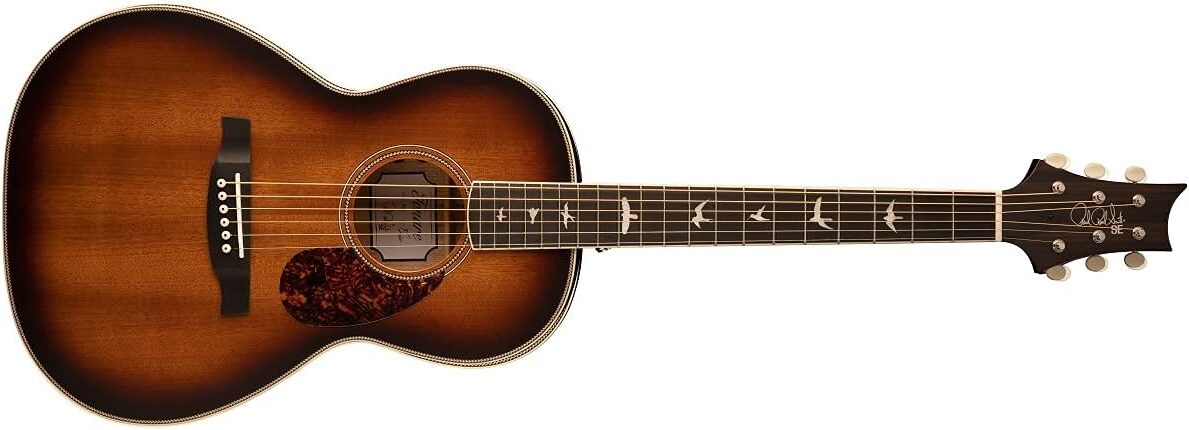
Our focus lies on the PRS SE Parlor P20E Acoustic-electric Guitar, designed in an appealing Tobacco Sunburst tint.
It’s a professional-grade quality 6-string acoustic-electric instrument, complete with a standout mahogany top.
The standout features incorporate a touch of elegance with its ebony fingerboard, perfectly complementing the mahogany style design.
This guitar doesn’t just offer a great look, but also a solid construction with back, sides, and neck all made of high-quality mahogany.
This instrument is produced by renowned brand, Paul Reed Smith, known for exceptional craftsmanship and quality musical instruments.
Adding to its unique character, it’s crafted with mahogany wood for fretboard material, ensuring premium playability and tone quality.
One key feature that sets it apart is its piezo pickup configuration, which enhances its acoustic-electric capabilities.
Designed with a right-hand orientation, it can be comfortably used by a vast majority of musicians.
In terms of string count, it comes standard with six strings, a common feature among acoustic-electric guitars.
This captivating instrument indicates a fusion of superior craftsmanship and elaborate design, characterized by the iconic Parlour size feature from PRS.
- My Review
Looking at the PRS SE Parlor P20E Acoustic-electric Guitar, one of the first things that strikes me is its beautiful Tobacco Sunburst color.
As I pick up the guitar, the right-hand orientation feels comfortable and familiar, without a doubt a match for most players.
What truly stands out to me is the richness afforded by the mahogany top, sides, and back – a level of depth and resonance that only a professional-grade guitar like this can produce.
Furthermore, the Mahogany Neck provides a soft surface that is resilient yet accommodating, perfect for extensive guitar playing sessions.
Examining the guitar further, I can’t help but admire the ebony fingerboard – its sleek, smooth surface makes every glide effortless and imparts a premium feel to this instrument.
Complementing this is the fretboard, crafted from mahogany wood that paints a picture of durability and dependability that’s such an essential aspect of a guitar like this.
The nuanced design of the Piezo pickup configuration is another facet I admire, it balances the guitar’s acoustic and electric components perfectly, providing a tonal balance that is both unique and pleasing.
The guitar boasts a remarkable 6-string configuration, providing a vast tonal spectrum that ensures a beautiful sound regardless of your preferred genre.
Another distinctive feature of this Paul Reed Smith masterpiece is undoubtedly its parlor-sized acoustic-electric dimension.
This combination imparts a certain dexterity to the instrument, providing a user-friendly design without compromising on the projected output or tonal richness.
However, despite its numerous commendable features, I did find one element I was not completely sold on.
While the smaller size does lend a level of portability and convenience, some may find the smaller body style a bit lacking if they’re accustomed to larger, full-bodied guitars.
But of course, this is largely a matter of personal preference.
Nonetheless, it’s worth taking into account if you’re considering the PRS SE Parlor P20E for its Acoustic-electric capabilities.
This is a well-crafted, well-designed guitar that merges beauty and functionality in equal measure.
It encapsulates what makes a Paul Reed Smith guitar distinctive: great care to detail, superior craftsmanship, and a commitment to delivering the best sound possible.
- Pros:
- Pro-grade parlor-sized acoustic guitar.
- Equipped with mahogany and ebony wood.
- Piezo guitar pickup configuration.
- Cons:
- Only available in right hand orientation.
My final verdict is that the PRS SE Parlor P20E Acoustic-electric Guitar – Tobacco Sunburst is an incredible investment for any music enthusiast.
The Mahogany top and back provides a rich, full-bodied tone that is truly unparalleled, making it perfect for both professional performances and jam sessions.
The aesthetic Tobacco Sunburst color and the high-quality ebony fingerboard offers a level of sophistication and smooth playability that exceeds expectations.
Finally, the unique piezo guitar pickup configuration only adds to its distinctive versatile sound and usability.
It’s a premium choice for those who value top-notch sound quality and aesthetics in their acoustic-electric guitars.
Larrivee OM-40 Legacy Acoustic Guitar
High-quality woods, superior craftsmanship, exceptional sound
Constructed with a Sitka spruce top and rosewood back and sides, this acoustic guitar ensures quality sound and durability. Its single piece mahogany neck, coupled with an ebony fingerboard and bridge, enhances the guitar’s overall performance. Equipped with Grover 18:1 tuners and a Bone(CNC Made) saddle and nut, it guarantees excellent tunability and acoustic resonance.
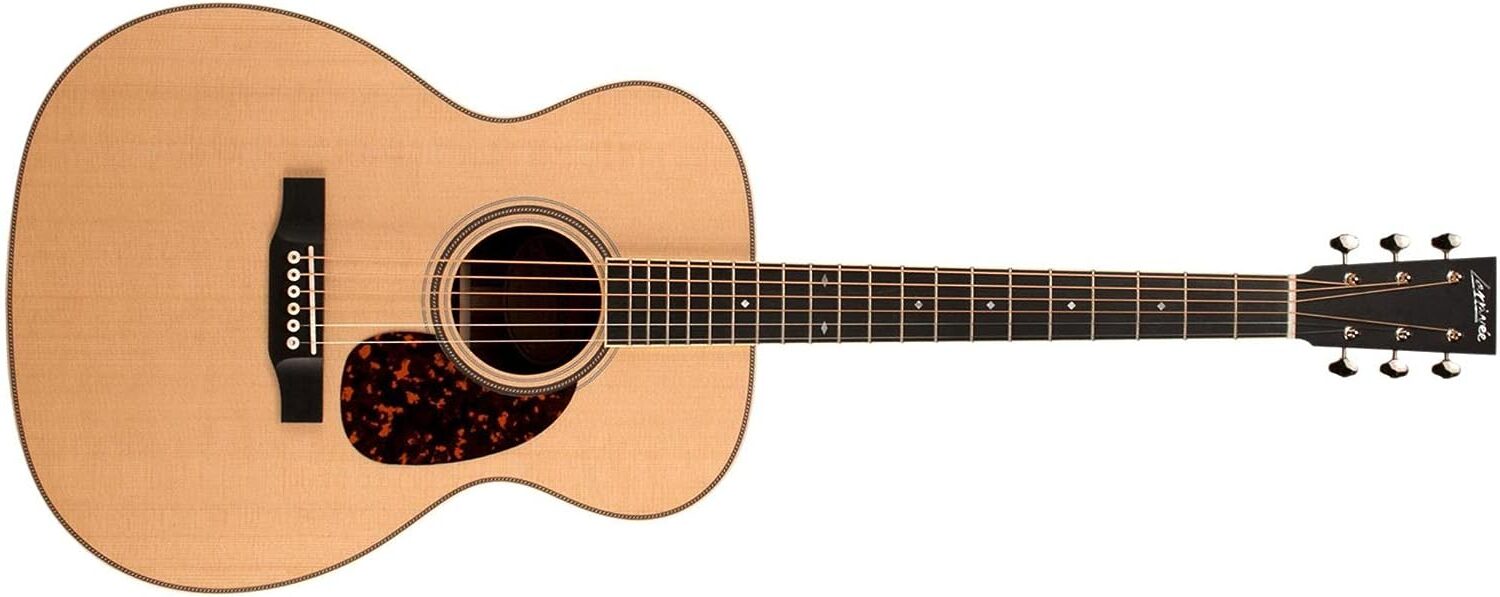
The Larrivee OM-40 Legacy Rosewood Acoustic Guitar comes in a classic natural color that enhances its elegance.
It features a Sitka spruce top coupled with a stunning rosewood back and sides that offer a unique aesthetic appeal.
Adding to its sleek design is a single piece of mahogany for the neck, contributing to a more comfortable and smooth playability.
The guitar also boasts of an ebony fingerboard and bridge, which add more value to the overall quality of the instrument.
To ensure precision tuning, it is equipped with Grover 18:1 tuners, known for their excellent tuning stability.
This particular model also comes with a bone (CNC made) saddle and nut, enhancing resonance and projection of sound.
Essential specifics to note include the top material type which consists of a blend of rosewood, mahogany wood, ebony wood, and spruce wood – all contributing to superior sound quality and durability.
Its body made from Sitka Spruce and a neck of rosewood material ensures a robust structure. The hand orientation is designed for right-handed users and the setup features six strings.
The natural, timeless design of the OM-40 legacy model combined with its supreme sound and playability qualities make this Larrivee guitar one to consider for any serious musician.
- My Review
As soon as I held the Larrivee OM-40 Legacy Rosewood Acoustic Guitar Natural in my hands, I’ve noticed the meticulous craftsmanship and superior materials used.
The body made from Sitka spruce exhibits a sturdy construction, indicating that this is a guitar built to stand the test of time.
What particularly intrigued me was the rosewood backing – a lush and rich texture that gives the guitar a unique character.
Building further on character, the ebony fingerboard and bridge lend an elegance to its already impressive appearance.
Meanwhile, the mahogany neck struck a balance between aesthetics and functional ergonomics, combining comfort with a delightful visual appeal.
Every strum was paired seamlessly with the 18:1 Grover tuners, providing me with better tuning precision and stability as I strummed each chord.
The Bone (CNC Made) saddle and nut also played a big role in terms of enhancing the general tone of the guitar.
Transitioning onto playability, I realized the action might be a bit too high.
This high action could potentially be a hurdle for beginners, as it requires a bit of strength to press the strings onto the frets.
However, with the help of a good luthier, the action could easily be adjusted according to personal preference – a small pitfall that can be handled with ease.
Now, moving onto the sound, the guitar seemed to resonate with an amazingly clear and bright tone – a testimony to its high-quality craftsmanship.
The rosewood, often hailed for its rich tonal quality, did not disappoint as it lent the guitar a warm resonance which was truly pleasing to the ear.
Suiting an assortment of musical genres, the six-string Larrivee OM-40 Legacy Rosewood Acoustic is right-handed, offering a versatile and comprehensive experience, satisfactory to both novice players and seasoned musicians alike.
Though some aspects left room for adjustments, in my experience, the overall execution of the Larrivee OM-40 Legacy Rosewood Acoustic Guitar does tend to leave a rather strong impression.
With a few tweaks and tuning, it could serve as a reliable and worth-while investment for guitar enthusiasts and professional musicians.
Despite certain downfalls, these do not overshadow the well crafted, elegant, and superior sound quality that this guitar provides, making it a fine addition to a musician’s arsenal.
- Pros:
- High quality materials.
- Great sound output.
- Detailed craftsmanship.
- Cons:
- High action setup from factory.
- May require additional setup costs.
- Not suitable for beginners.
My final verdict is that the Larrivee OM-40 Legacy Rosewood Acoustic Guitar is a masterpiece of craftsmanship and sound.
The guitar’s Sitka spruce top and rosewood body create an unmatchable resonance and rich tones.
With features like the single-piece mahogany neck and ebony fingerboard and bridge, the guitar ensures long-lasting durability and an exquisite playing experience.
Also, the Grover 18:1 tuners and bone (CNC Made) saddle and nut add an extra edge to its performance.
This guitar is nothing short of an investment for every serious guitarist looking for quality, reliability, and superior sound.
Jasmine S-34C Cutaway Acoustic Guitar
Excellent playability with rich, well-balanced sound.
This acoustic guitar takes pride in its spruce top with Jasmine’s Advanced “X” Bracing, sapele back and sides that offer a rich, well-balanced sound. Its full 25-1/2″ scale length and slim neck provide a comfortable feel and excellent playability. Smooth satin finish enhances the resonance, ensuring optimal sound quality.
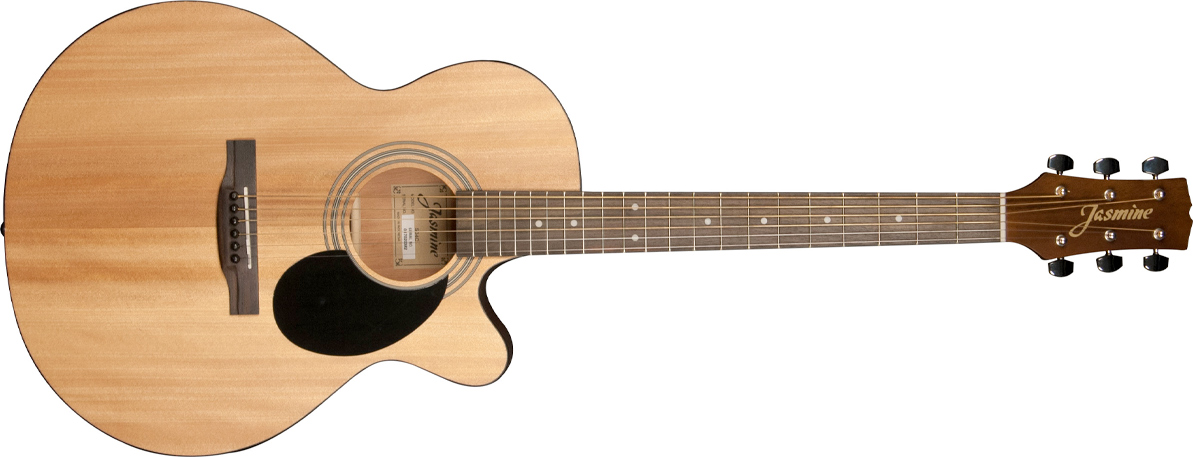
The Jasmine S-34C Cutaway Acoustic Guitar is undeniably an attractively designed instrument. This grand orchestra-style guitar boasts a distinctive Venetian-style cutaway, which not only enhances its appearance but also improves functionality.
This musical instrument features a top made of select spruce material, that’s been reinforced with Jasmine’s ‘Advanced X Bracing’ technology. Additionally, it boasts a back and sides constructed from sapele wood, all contributing to its balanced and resonant sound.
Noteworthy is its neck design which is slim in profile coupled with a full scale length of 25-1/2″. This design brings the advantage of incredible playability and a very comfortable feel to players. Also, the fingerboard and bridge are both crafted from quality rosewood.
One of its main attractions is the smooth satin finish, that not only adds an aesthetic touch but also amplifies the resonance for superior sound quality. As such, it is an instrument that’s both stylish and easy to play, making it a great value deal for any musician.
Finally, it’s worth mentioning that the Jasmine S-34C is a 6-string guitar, offered in a natural color that enhances its overall appeal.
- My Review
I am captivated by the stylish grand orchestra-style design of the Jasmine S-34C Cutaway Acoustic Guitar Natural.
It’s apparent that quality materials have been employed, including rosewood for the body, fingerboard, and neck, while the top material artfully combines spruce plywood and sapele wood.
The Venetian-style cutaway is quite graceful, adding to the instrument’s overall appeal.
Offering more than just good looks, the sound quality is rich and well-balanced, a feature I particularly enjoyed.
Its select spruce top with Jasmine’s Advanced “X” Bracing, and sapele back and sides give a resonant sound that makes playing this guitar a dream.
I can’t fail to mention the slim neck profile, which contributes significantly to its easy playability.
The full 25-1/2″ scale length supplements this playability, providing a comfortable feel for any discerning guitarist.
The guitar comes in a natural color, exuding an effortless charm that appeals to guitarists who appreciate class and style.
Its finishing is not only smooth but also satin, which on my own experience escalated the guitar’s resonance resulting in an optimal sound quality.
With six strings, it sits comfortably in the category of traditional acoustic guitars and is capable of outperforming many within its range.
The S-34C Cutaway Acoustic Guitar, I feel, represents great value, especially for players looking for a well-built and easy-playing instrument.
Despite its excellent features and style, I noted a few challenges.
It does require tuning more frequently than some of its counterparts, but this is a small price to pay for the otherwise excellent performance.
Moreover, the raft of features and incredible design of this instrument allows you to overlook the minor tuning inconvenience.
From my perspective, the Jasmine S-34C Cutaway Acoustic Guitar Natural is a sound investment for both beginner and seasoned guitarists.
- Pros:
- Well-balanced sound quality.
- Comfortable feel and excellent playability.
- Advanced “X” Bracing for support.
- Cons:
- Not suitable for professional use.
- May need regular maintenance.
My final verdict is that the Jasmine S-34C Cutaway Acoustic Guitar is truly remarkable.
With its spruce top and Advanced ‘X’ Bracing, it guarantees incredible sound quality.
The slim neck and full 25-1/2″ scale length make it exceptionally comfortable for players of all levels.
If you’re looking for a well-built, easy-to-play, and affordably priced guitar, this is undoubtedly the best pick for you.
Highly recommended.
Fender Malibu Player Acoustic Guitar
Acoustic guitar with unique style and superb playability.
This acoustic guitar is designed with a unique small-body Malibu shape and features a solid spruce top and mahogany back and sides. It includes a slim-taper “C”-shaped mahogany neck and a Fender-exclusive CD-1 Fishman preamp system. With a Natural finish and Walnut fingerboard, this guitar ensures balanced sound and high playability, perfect for any style.
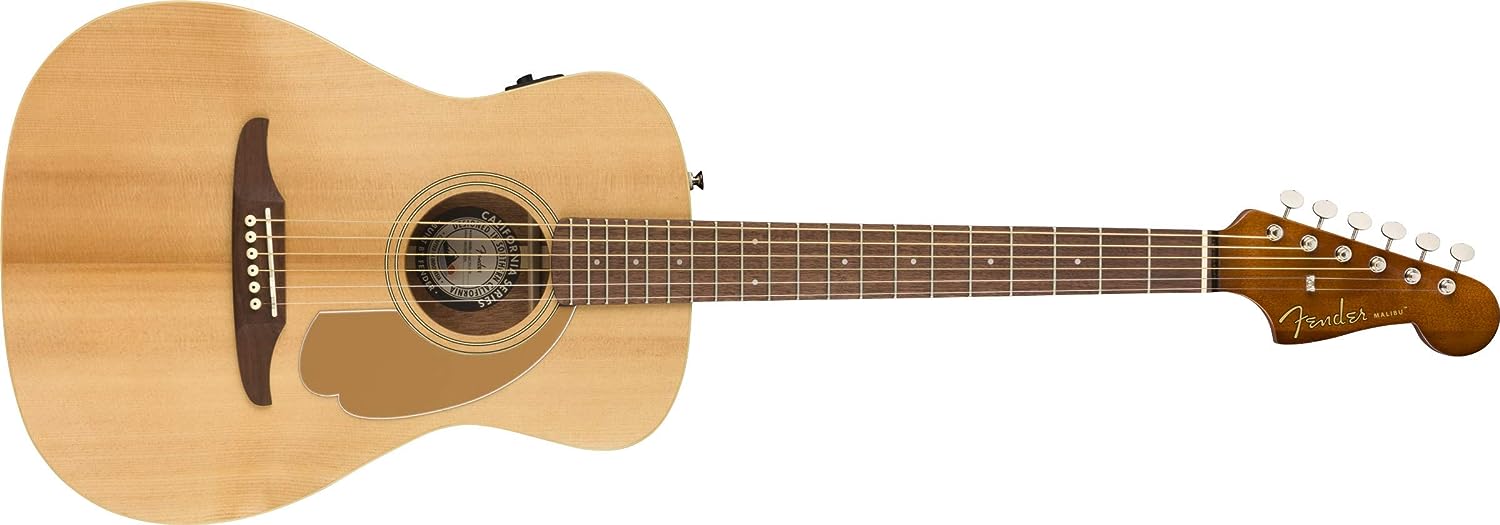
The Fender Malibu Player Acoustic Guitar boasts an exclusively designed body shape, giving it a unique aesthetic appeal.
Constructed with a solid spruce top, and sides and back made of mahogany, the guitar guarantees durability and quality sound production.
The acoustic guitar also incorporates a Fender-patented CD-1 Fishman pickup/preamp system to provide an impressive amplified sound.
The guitar’s neck is also made of mahogany, but has a slim-taper “C”-shaped profile, taking inspiration from Fender’s electric guitar lineup.
Combined with a walnut fingerboard and bridge, the guitar secures good playability.
The lookahead of the guitar is featured by a 6-in-line headstock.
All these elements, from its unique color to its material constitution, speak volumes about the guitar’s brand – Fender.
The top is a combination of mahogany and spruce wood, and the back is made of walnut and mahogany wood creating an interesting blend of materials.
The guitar is configured with a piezo pickup, and its strings are made of phosphor bronze for a rich sound.
This Fender Malibu Player Acoustic Guitar is specifically designed for right-handed players.
The craftsmanship of this guitar allows players to explore new chords and melodies with its small body and short scale.
Its bold style and balanced sound make it a perfect partner for both stage performances and studio recording sessions.
Every aspect of the construction process is done without compromising, ensuring a high-quality guitar.
- My Review
Experiencing the Fender Malibu Player Acoustic Guitar definitely made me appreciate the distinctive Malibu body shape.
As I held it in my hands, the sleek Malibu design just seemed to fit perfectly, making playing a pure joy.
What truly sets it apart is the solid spruce top coupled with the mahogany back and sides.
The choice of materials not only ensures durability, but most importantly influences the guitar’s sound quality.
As far as the sound goes, the guitar may not provide the loudest output, but the tone is absolutely top-notch.
Moreover, the Fender-exclusive CD-1 Fishman pickup/preamp system permits decent amplification, preserving the natural sound of the guitar.
Another aspect that took my attention was the slim-taper “C”-shaped profile of the mahogany neck.
Such a feature was indeed inspired by Fender’s electric legacy, providing a comfortable feel and easier playability.
Even those unfamiliar with electric guitars will appreciate its comfort and ease of playing.
I was particularly impressed by its unique 6-in-line headstock, a design detail that not only adds to its aesthetic appeal but also its playability.
The GraphTech NuBone nut and saddle further contribute to this instrument’s superior resonance and balanced sound.
As for the walnut fingerboard and bridge, the wood selection truly pays off, offering a smooth experience and enhancing the instrument’s overall sustainability and longevity.
Strummed acoustically or plugged in, the Malibu Player has a distinctive and satisfying tone.
The onsite Piezo pickup also does a fantastic job of ensuring the guitar sounds just as good electrified.
While the natural color and the material composition may cater to a simplistic taste, the quality of design and attention to detail allows it to stand out among its competitors.
Finally, its right-hand orientation is worth noting, as it adheres to the common style of play for most guitarists.
The Fender Malibu Player acoustic guitar provides a great piece for both, stage performances and studio recordings, winning over those willing to stand out from the crowd.
- Pros:
- Solid spruce top and mahogany sides.
- Comfortable, slim-taper “C”-shaped profile.
- Fender-exclusive CD-1 Fishman pickup/preamp system.
- Cons:
- Not suitable for those seeking loud sound.
My final verdict is that the Fender Malibu Player Acoustic Guitar is a perfect companion for those aiming to disrupt the status quo in their musical journey.
Its unique construction quality, including a solid spruce top and mahogany back and sides, offers both style and superior resonance.
The Fender-exclusive Fishman preamp system effectively reproduces the guitar’s natural sound, making it equally excellent for stage and studio use.
Whether you’re a new player learning your first chords or an experienced artist seeking a new sound, this guitar, with its comfortable feel and versatility, shouldn’t be overlooked.
Martin LX1E Little Martin Acoustic-Electric Guitar
Versatile, quality sound with sustainable, premium craftsmanship.
This compact acoustic-electric guitar by Martin impresses with a Sitka spruce top and a mahogany high-pressure laminate construction that ensures durability. It provides professional sound, enhanced playability, and captivating appearance, thanks to its certified sustainable wood parts and a warm satin finish. Ideal for beginners to experienced players, it is versatile for all kinds of music genres and perfect for travel, studio sessions, and jamming.
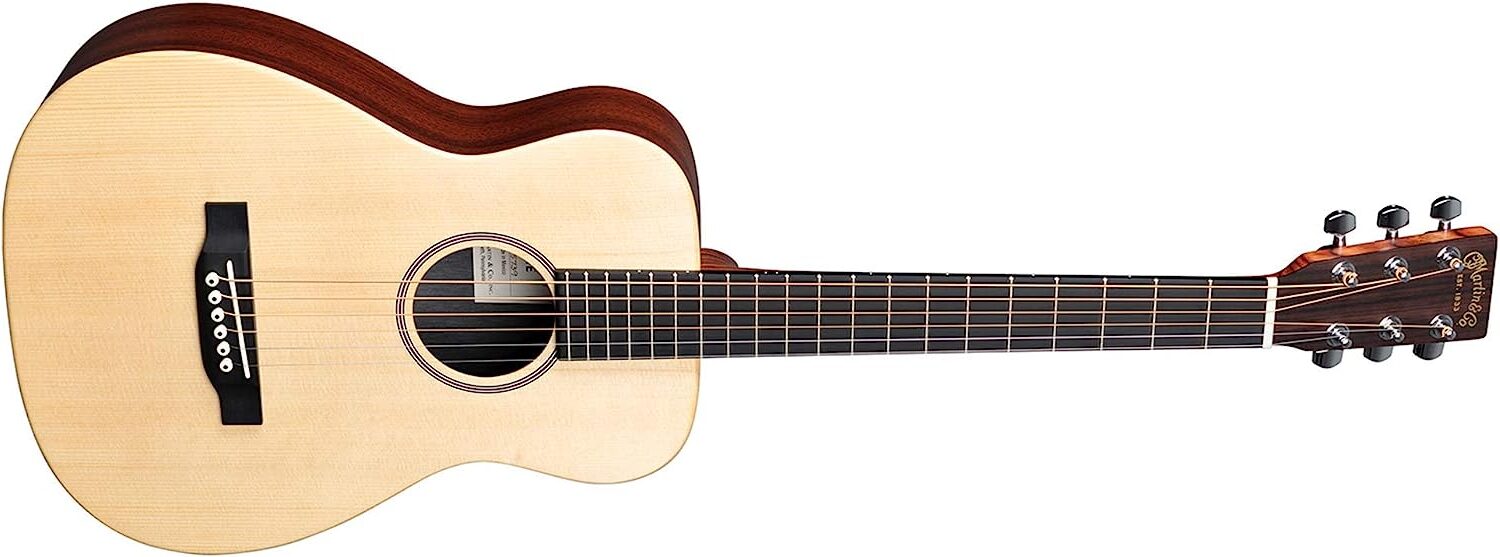
The Martin LX1E Little Martin Solid Sitka Spruce/Mahogany HPL Acoustic/Electric Guitar is quite a compact instrument, yet it doesn’t compromise on either the quality of its sound or its construction.
Built with high-pressure laminate (HPL) and a Sitka spruce top, this guitar may be small, but its sound quality and tone are anything but.
However, it’s not just about the sound with this guitar, it packs a punch in terms of its look too.
The body of the guitar, made with a Sitka spruce top and mahogany HPL back and sides, boasts a warm satin finish that exudes elegance and sophistication.
Its sustainable wood parts, non-scalloped X-Brace, standard tapered neck, and chrome-enclosed gear tuners make this guitar a visually impressive piece.
Martin’s Little Martin guitars, made from the finest wood, are crafted to withstand hours of playing, whether it’s late night jamming or a heated studio session.
Another distinguishing feature of this guitar is its enhanced playability, regardless of your skill level or music genre preference.
In the end, what you have is a handcrafted, solid-wood acoustic-electric guitar that combines traditional designs with professional-grade sound.
Let’s not forget, it’s made keeping in mind sustainability, with certified wood parts, and is as durable as they come.
Speaking of the guitar’s specifications, the top material is wood, the body and neck material are both Mahogany and the fretboard material is Morado.
The Martin LX1E is fitted with Phosphor Bronze strings and Fishman Isys T electronic pickups, enhancing the guitar’s amplified sound.
Designed primarily for right-hand players, this model also comes with a gig bag for ease of transportation.
Martin provides a classic acoustic guitar with a modern twist, ideal for musicians of all calibers.
Remember, this is a genuine Martin creation, a brand renowned for its high-quality instruments and dedication towards maintaining the highest standards of craftsmanship.
- My Review
Upon first inspection, the Martin LX1E Little Martin Solid Sitka Spruce/Mahogany HPL Acoustic/Electric guitar left me truly fascinated.
Boasting a combination of Sitka spruce top and mahogany high-pressure laminate (HPL) construction, this striking instrument is eye-capturing and supports sustainable wood utilization.
Although it’s Martin’s smallest guitar, it’s excellent on tone, quality, and versatility, making it a delight for both campfire jam sessions and at-home practice.
This guitar isn’t just about sound; it’s also geared up with a warm satin finish and a stylish non-scalloped X-Brace.
Being handcrafted from the highest-quality wood, it’s engineered to endure late-night jams, long studio sessions, and extensive strumming or picking.
Moreover, these guitars are solid-wood and acoustic-electric, providing a perfect blend of traditional designs, professional sounds, and comfortable playing.
What greatly enhanced my playing experience was its enhanced playability.
No matter if I am playing rock, country, folk, bluegrass, or jazz, this guitar delivers a natural playing experience that you will absolutely love.
On a cosmetic level, Martin has given careful attention to selecting the materials for this guitar.
With a body made of reliable mahogany wood, a fretboard material type of morado, and a cool guitar pickup configuration using Fishman Isys T, this acoustic guitar has a superior design and string material type of Phosphor Bronze.
However, something that requires improvement is the sound when not using an AMP.
It seems to not quite live up to expectations for a guitar of this price range.
As for the durability and sustainability element, Martin has done an exceptional job with handcrafting this instrument with heavy-duty materials like sustainable wood.
Designed with innovative styles and time-tested techniques, the Little Martin series offers classic acoustic guitars that are a joy to play.
They are perfect for travelling, and their smaller size makes it an ideal option for novice musicians or for those playing in tighter spaces.
This guitar mostly exhibits a great understanding of musicians’ needs regardless of their skill level.
However, there is one minor point that offsets the guitar’s otherwise perfect balance; the included tuner seems to be a few cents sharp and not too precise.
Minor adjustments and tuning may be needed to hit that perfect note.
In the end, I find it hard not to recommend the Martin LX1E Little Martin Acoustic/Electric guitar to anyone seeking a compact, yet reliable and beautiful guitar.
- Pros:
- Compact yet high-quality construction.
- Excellent tone and versatility.
- Sustainable wood utilization.
- Cons:
- Quieter sound without amplification.
- Included tuner slightly imprecise.
- Pricier than some alternatives.
My final verdict is that the Martin LX1E Little Martin Solid Sitka Spruce/Mahogany HPL Acoustic/Electric Guitar is an extraordinary addition to any musician’s collection.
With its professional sound, superior appearance, and enhanced playability, it provides an incomparable playing experience regardless of your music genre.
The sustainable wood and high-pressure laminate construction assures durability, making it perfect for both – late-night jams and studio sessions.
Moreover, the inclusion of a gig bag adds value to the purchase.
Undoubtedly, it’s an ideal choice, be it for beginners or for professional musicians looking for a reliable travel guitar.
Taylor 814ce Acoustic-Electric Guitar
High-quality materials for superior sound and feel.
This top-class guitar is made from a variety of woods such as ash, maple, mahogany, ebony, and spruce, with a rosewood body and mahogany neck. The acoustic-electric instrument includes Indian Rosewood back sides, an ebony fingerboard, V-Class Bracing and is geared towards right-hand players. With a natural color finish and a scale length of 25.5 inches, it provides a sumptuous experience to guitar enthusiasts.
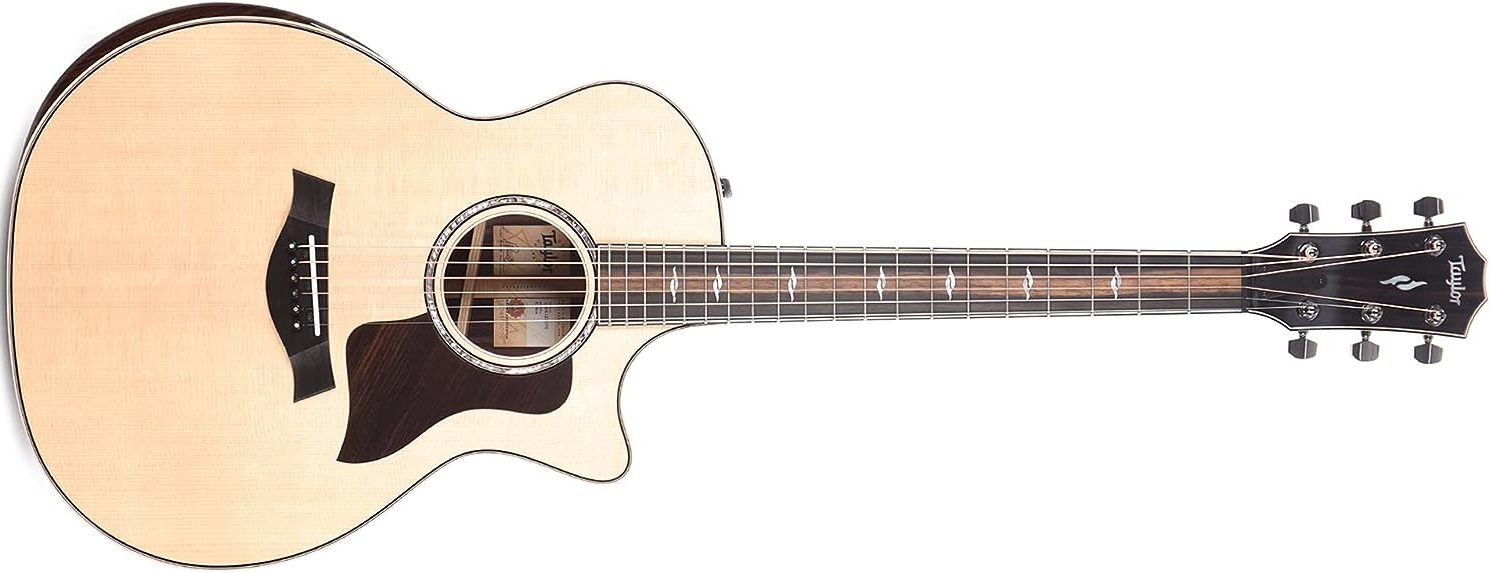
You’d likely be hard-pressed to find a more striking and practical instrument than the Taylor 814ce Acoustic-Electric Natural guitar.
It boasts a comfortable, ergonomic design featuring a radiused armrest, coupled with the innovative structure of V-Class bracing which elevates its musical capabilities.
This masterpiece is crafted from a range of authentic materials like rosewood, mahogany and ebony to enhance sound quality, durability and aesthetic appeal.
With a top carefully made from spruce, ash, maple, rosewood, mahogany, and even ebony, the guitar produces a rich, vibrant sound.
A significant portion of its solid and sturdy body comprises of rosewood while the back is also made from a combination of rosewood and mahogany.
The mahogany addition in the guitar extends to its neck, which is complemented by a fretboard built from the same material.
Notably, the choice of mahogany for these parts adds a warm tonal quality to the instrument.
Adhering to a more traditional design, the guitar is created for the right-handed player and fitted with nickel strings which help contribute to its crisp, clear sound.
With a scale length of 25.5 inches, it provides a great balance between easy playability and rich, full-bodied tone.
The Taylor 814ce acoustic-electric guitar is not just a musical instrument, but a well-crafted piece of art built for the best musical experience.
- My Review
When I first picked up the Taylor 814ce Acoustic-Electric Guitar, the natural finish immediately caught my eye.
Appreciating the construction, I noticed the top material comprises an eclectic mix, from ash wood to spruce wood, which contributes to its distinct sound quality.
Flexing the strings produced a clear tone, demonstrating the quality of the nickel strings.
As a right-handed player, the guitar was already aligned perfectly for my playing style and the scale length of 25.5 inches, typical of most Taylor guitars, gave it a familiar feel.
The Indian rosewood back and sides, combined with the mahogany neck, not only provided a visually pleasing contrast but also contributed to the guitar’s overall balanced tone.
Often overlooked, but I was pleased to find the subtle addition of a radiused armrest, elevating the comfort level immensely during extended play sessions.
Examining closely, the spruce top wood is beautifully crafted and feels robust, likely to withstand the rigors of live performances.
However, it was the distinct V-Class Bracing structure that sets this guitar apart, enhancing both volume and sustain.
Running my fingers along the ebony fingerboard, I found the action suitable and the fretboard quite responsive to both gentle strumming and aggressive picking.
In playing this guitar, I was pleased with the robust sound, and the built-in electronics faithfully conveyed the acoustic nuances when connected to an amplifier.
Although this guitar is indeed a high-quality instrument, it’s perhaps not suited for the absolute beginner due to the complexity of its features and the investment required.
Transitioning between chords, I found the mahogany neck to be smooth and highly playable, the careful workmanship evident in each detail.
To their credit, Taylor has indeed created a versatile guitar that accommodates a variety of music styles, from blues to rock.
My experience with the Taylor 814ce Acoustic-Electric Guitar was mostly positive, thanks to the thoughtful design and excellent materials used in its construction.
Definitely, this guitar manifests Taylor’s commitment to deliver not just a mere instrument, but a piece of art that enhances the musical journey.
Although a considerable investment, the overall craftsmanship and advanced features could justify the cost for an experienced guitarist seeking to upgrade their equipment.
Without a doubt, the Taylor 814ce is a testament to their unwavering dedication to quality.
- Pros:
- Diverse top material type.
- Superb V-Class Bracing.
- Right hand orientation.
- Cons:
- Not suitable for left-handed players.
- Potentially expensive.
My final verdict is that the Taylor 814ce Acoustic-Electric Guitar is an outstanding guitar in the Taylor line-up.
With its intricate V-Class bracing and precision, you get outstanding sound quality and projection.
Both the Indian rosewood back and sides provide a rich aesthetic appeal and contribute to its warm, resonant sound.
The radiused armrest brings comfort during play, which is a plus for those long jamming sessions.
Regardless of whether you are a professional musician or a passionate hobbyist, the Taylor 814ce is a worthy investment.
Fender CD-60S All-Mahogany Dreadnought Acoustic Guitar
High-quality, affordable dreadnought with superior tone
This high-quality acoustic guitar boasts an all-mahogany body and top for an organic tone. The comfortable neck, chrome tuners, and 20-fret rosewood fingerboard make it excellent for diverse playing needs. A combination pickup configuration and phosphor bronze string material round out this right-hand oriented instrument, making it perfect for any setting.
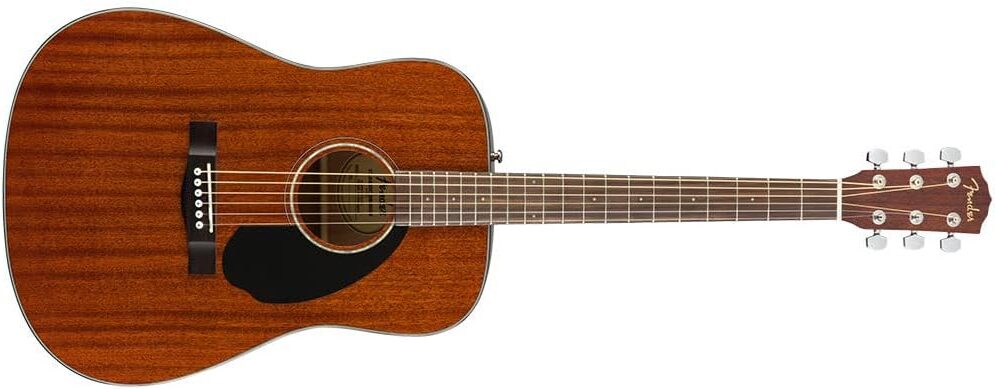
This Fender CD-60S acoustic guitar is crafted entirely from mahogany, painted in an alluring all-mahogany color.
This dreadnought style guitar features a distinct natural finish, showcasing both the top and back sides as laminated mahogany.
The 25.5″ scale neck, also made from mahogany, hosts a 20-fret rosewood fingerboard, allowing for numerous possibilities for musical expressiveness.
This guitar is also equipped with chrome die-cast tuners, guaranteeing its capacity to keep the notes in tune.
Ancreased playability comes from the presence of a 12″ fingerboard radius, enabling your hands to glide seamlessly over the fingerboard.
Although this Fender guitar does not include a case, its extensive features substantiate its value.
The materials used in its construction, which include top, body, neck, back, and fretboard all fabricated from mahogany wood, as well as strings constructed of phosphor bronze, ensure its exceptional tonal quality and longevity.
One aspect that notably widens the range of sounds is the combination guitar pickup configuration.
Finally, as this model is designed for right-handed musicians, it’s the perfect choice for the majority of potential users.
Emphasizing its versatility, the Fender CD-60S All-Mahogany is ideal for a variety of environments, be it your living room, a beach, or a coffeehouse, making it a versatile instrument that brings classic Fender sound and playability wherever you need it.
- My Review
Right away, I was astounded by the luster and elegance of this Fender CD-60S All-Mahogany Dreadnought Acoustic Guitar.
Dressed in a natural finish, the solid mahogany top composition lends a distinctly organic flavor that only adds to the overall appeal.
The use of laminated mahogany for the back and sides simply demonstrates Fender’s commitment to excellent craftsmanship.
This guitar is augmented by a 25.5″ scale mahogany neck that feels sturdy and comfortable underhand, contributing to a satisfying playing experience.
A noteworthy feature, in my opinion, is the 20-fret rosewood fingerboard,
With its 12″ radius, it showcases a bold design that does not sacrifice playability.
I found the chrome die-cast tuners and the combination guitar pickup configuration to truly amplify the resonance and articulation that this instrument harbors.
However, the instrument does warrant some negatives as well.
The model I tried arrived with a neck requiring adjustment and the high E string wasn’t sounding quite right.
Although adjusting the truss rod improved the sound, these issues might provide a hiccup for beginners who are unfamiliar with such guitar nuances.
Another letdown was noticing a variability in the fret heights which might suggest a lack in the quality control department.
Playing certain notes was a challenge due to this, and there was a noticeable fret buzz as well.
Additionally, although the case wasn’t included with the product, it would have been useful to provide the option, given the design and quality of the guitar.
Despite these hiccups, the sound produced by the phosphor bronze strings, coupled with the overall string material and setup, is pleasantly warm and loud.
The Fender brand and the all-mahogany design ensure for a reliable and aesthetically pleasing musical instrument, which makes for both a fantastic strummer and an equally great looker.
This guitar is ideal for venues like the couch or the beach, and equally for a cozy performance under the soft lights of your local coffeehouse,
The guitar’s right-hand orientation makes it accessible for a wide range of musicians.
On a final note, the range of positives this guitar brings to the table – particularly the sheer sound quality and the ease of play – do certainly outshine the few negatives there are to be found.
- Pros:
- Quality craftsmanship.
- Beautiful wood finish.
- Good sound and intonation.
- Cons:
- Quality control issues.
- Arrived with loose parts.
- Inconsistent fret heights.
My final verdict is that the Fender CD-60S All-Mahogany Dreadnought Acoustic Guitar is a top-notch instrument that delivers outstanding sound quality.
The solid mahogany top lends this model a unique organic flavor, making it stand out among other guitars.
It is perfect for various environments, from the comfort of your couch to the bustling environment of a coffeehouse.
Affordability and high-quality have been brilliantly married in this product, ensuring that excellent playability doesn’t cost a fortune.
I highly recommend this guitar for anyone looking for great tone, superb performance, and value for money.
Epiphone Slash J45 Acoustic-Electric Guitar
Quality Acoustic Electric Guitar with Mahogany Body
This mahogany-bodied guitar, in a beautiful November Burst finish, is fitted with a spruce wood top and laurel wood fretboard. It includes a piezo pickup configuration for electric amplification and comes with a protective case, ideal for transportation. Providing a right-hand orientation and six-string setup, it’s a perfect choice for both beginners and seasoned musicians.
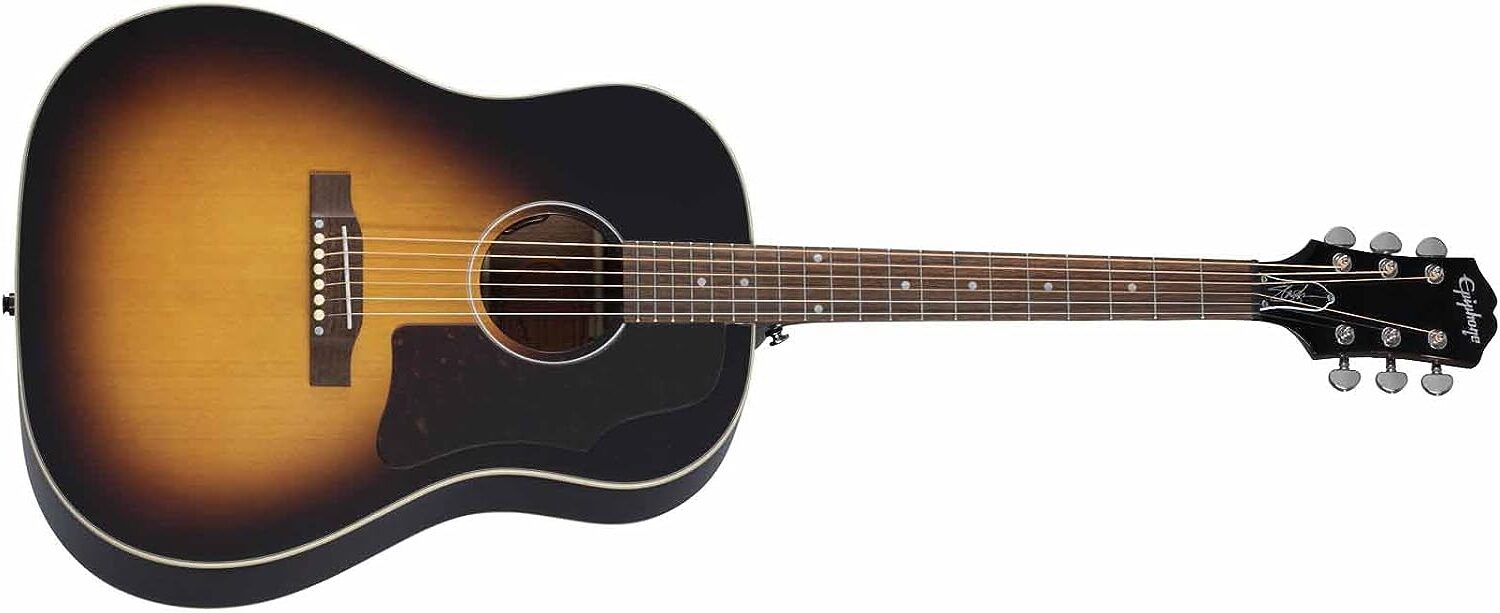
Looking at the Epiphone Slash J45, one immediately notices the striking color, November Burst. It’s visually stunning and impossible to overlook.
This guitar is the brainchild of the renowned music instrument manufacturer, Epiphone. They’re known for their meticulous craftsmanship.
One of the key features of this acoustic electric guitar is the high quality Spruce Wood used at the top of the guitar’s body.
Adding to its exquisite build, both the body and the neck of the guitar are made from Mahogany, a wood known for its robustness and excellent resonate properties.
In addition to the Mahogany body and neck, the back also features Mahogany Wood enhancing the overall harmonics and tone of the instrument.
Upon close examination, you’ll see that the fretboard is made with Laurel Wood, adding a unique richness to the sound.
The Epiphone Slash J45 is additionally equipped with a Piezo pickup configuration. This allows the user to amplify the sound while keeping the acoustic tones intact.
This guitar is a right-handed model with six strings. Therefore, it is suitable for all right-handed guitarists, regardless of their skill level.
To provide convenience and protection, the Epiphone Slash J45 comes with its own guitar case. This makes the guitar portable and easy to store when not in use.
- My Review
After laying my hands on the Epiphone Slash J45 Acoustic Electric Guitar, the first thing I appreciated was its stately November Burst color.
Nothing less than the sight of autumn leaves, this hue subtly underlines the guitar’s Mahogany body and amplifies its aesthetic appeal.
Moving beyond the superficial attributes, as I glanced closely, I realized that it boasts a top made of Spruce wood.
On a careful strumming session, the guitar resonated with a crisp and clear sound, ably amplified by the Piezo pickup configuration.
The presence of this setup significantly augments the tonal balance of the guitar and offers a richer musical experience.
Further, the guitar plays host to a Laurel Wood fretboard and a Mahogany neck, both of which add an effortless fluency to my performance.
A shrewd mingling of these materials also contributes meaningfully to its endurance and robustness.
Assuredly, this blend ensures a seamless performance, no matter the finesse of your musical style.
Regarding the feel and hand orientation, this guitar caters comfortably to the Right-handed players and comprises of six strings, thereby offering a conventional yet favorable guitar experience.
I can’t stress enough by saying how crucial a harmonious and smooth performance is, and this guitar offers just that.
Coming to the actual impromptu session, upon trying it out for myself, it reminded me of the quaint rhythm of a soft rock or blues concert—simplistic yet profound.
Surprisingly, even in an intimate setup, it did offer a fairly promising range and projection that was tough to match.
Interestingly, the musical yield didn’t compromise on the warmth and resonance which lies at the heart of any acoustic performance.
Another charming aspect about this guitar is that, despite its overwhelming features, it discards any grandiose pretensions.
The price of the product will astound you when you consider the rich musical experience it offers—it’s an absolute steal.
No matter the intensity or the duration of your playing sessions, this acoustic electric guitar maintains its composure and doesn’t give in to untimely wearing.
This longevity is by no means an accident but a testimony to Epiphone’s superior craftsmanship and user-friendly approach.
- Pros:
- Excellent sound quality.
- Beautiful November Burst color.
- Durable spruce & mahogany materials.
- Cons:
- No left-hand orientation option.
- A bit pricey for beginners.
My final verdict is that the Epiphone Slash J45 Acoustic Electric Guitar is truly a high-quality instrument.
With its Spruce Wood top and Mahogany body and neck, it delivers an exceptional, fulsome sound that clearly reflects the premium building materials used.
The Piezo pickup configuration guarantees versatile and pleasant tones, fitting the needs of a wide array of music genres.
The marvelous November Burst color presents an aesthetically pleasing guitar that stands out in any ensemble.
This guitar is definitely a worthy investment for both novice and veteran guitarists.
YAMAHA FG800 Solid Top Acoustic Guitar
Quality sound, traditional looks, affordable Yamaha guitar.
Constructed with a solid sitka spruce top and nato back and sides, this guitar is perfect for beginner guitarists. It boasts a rosewood fingerboard, bridge, and an adjustable truss rod for a well-balanced yet robust sound. Apart from having a classic look, it features diecast tuners and a phosphor bronze string for a superior audio experience.
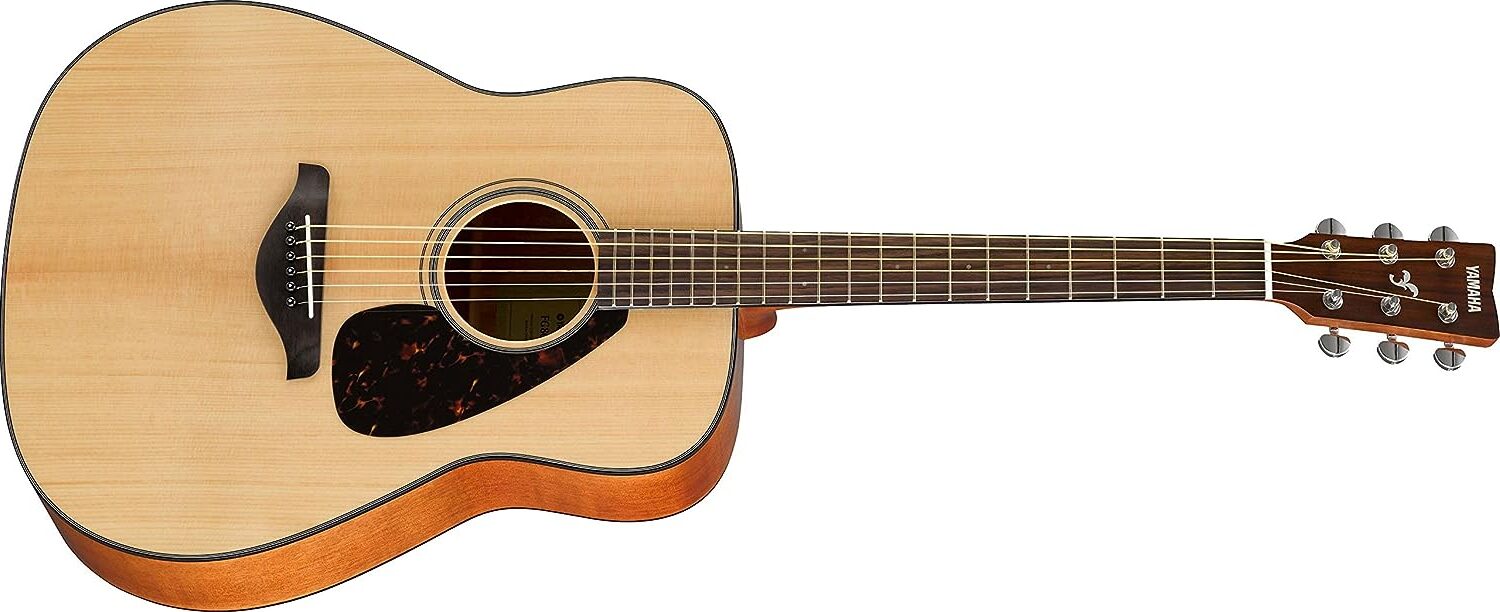
Here we have the YAMAHA FG800, an acoustic guitar purely for the music enthusiast.
You can easily notice its top made of solid sitka spruce wood that’s known for its superior sound quality.
With the back and sides made of Nato wood, the durability of this guitar is unquestionable.
Adding to the elegance, it comes with a fingerboard and bridge made of rosewood.
It also incorporates diecast tuners to ensure the perfect tone every time you play.
To customize your play, this guitar features an adjustable truss rod that you can fine-tune to your liking.
Seeing all this, it’s clear how Yamaha stays true to the commitment of delivering quality products.
The guitar has a natural finish, keeping the appeal of its materials as original as possible.
In the materials department, it’s interesting to see the use of Mahogany for the body, while the neck is made of Nato wood, and the fretboard comes in Rosewood.
It’s a right orientation guitar which simply means it’s designed for right-handed players.
Finally, the Yamaha promise of authentic sound that is well balanced yet strong is showcased in this model.
This indeed is a guitar that is recommended confidently to anyone just starting their musical journey.
- My Review
Upon receiving the Yamaha FG800 Solid Top Acoustic Guitar, I was immediately struck by the guitar’s immaculate exterior and construction.
Enclosed within a natural colored design, the body material composed of mahogany delivers a robust look and feel to the guitar.
The solid sitka spruce top, which is skillfully attached, garnered my appreciation for the exemplary materials used in the creation of this instrument.
On the back, I discovered the material to be rosewood, which enhances both the guitar’s aesthetic and overall sound production.
The neck, made of nato wood, felt strong and sturdy in my hands.
As I moved my fingers across the rosewood fingerboard, I could feel the precision with which it was crafted.
Further enhancing the guitar’s quality were the diecast tuners, designed to afford musicians like myself a smoother tuning experience.
What really stood apart for me was the guitar’s adjustable truss rod – providing great serviceability and capability of improving the instrument’s performance over time.
Explore the body further, I observed that the top material used was spruce wood and the string employed were made of phosphor bronze, reinforcing the durability of this superb instrument.
Upon playing, the resonance this guitar offered was deeply profound and truly astonishing
The melodious sound, so powerful and well balanced, belies its modest price point making it an absolute steal.
As far as playability, this guitar can confidently stand up to far costlier models, providing both ease of use for beginners and satisfaction for more seasoned players.
However, this guitar may necessitate some adjustments prior to playing as the setup didn’t seem quite right out of the box.
The action appeared too high, causing a bit of discomfort in my fingertips while playing chords.
After spending some time tweaking the setup and replacing the strings, the guitar’s performance drastically improved, and playing became a joy.
On a little downside, it’s worth noting that this guitar might arrive with minor damage, presumably from shipping, or could be down to quality control.
My unit had no such issues, but just know this could be a potential caveat.
In a nutshell, despite minor drawbacks, Yamaha’s FG800 is a truly remarkable instrument, offering outstanding quality and performance, combined with an affordable price, perfect for both beginners and more seasoned players alike.
- Pros:
- Outstanding quality and robust strength.
- Well balanced authentic sound.
- Good for beginners and professionals.
- Cons:
- Possible shipping damage.
- Setup may be required after purchase.
- High action out of the box.
My final verdict is that the YAMAHA FG800 Solid Top Acoustic Guitar is an excellent choice for beginners and intermediate players.
The solid-top design makes the guitar sound authentic and well balanced, without sacrificing robust strength.
The traditional looks and outstanding quality of materials used like sitka spruce top, rosewood fingerboard and bridge, nato back and sides, make it a long-lasting instrument.
The adjustable truss rod and the diacast tuners make it easy to customize for your individual playing style.
Considering the affordable price, I highly recommend this guitar to everyone, especially newcomers.
Epiphone DR-100 Acoustic Guitar
High-quality materials for superior sound and durability.
This ambidextrous guitar boasts a sleek SlimTaper C-profile neck, a durable mahogany body, and Epiphone Sloped Dovewing headstock. It’s equipped with top-notch Nickel hardware and premium die-cast tuners for quality sounds. With a spruce top and a rosewood fingerboard, this guitar guarantees excellent performance.
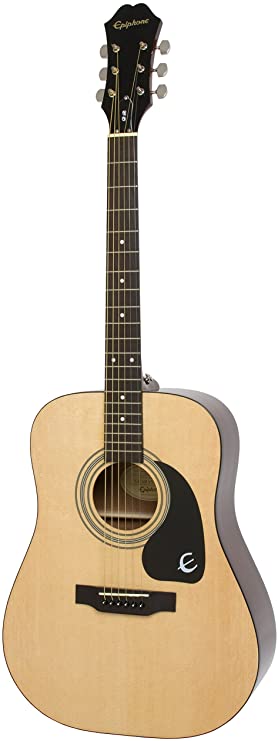
The Epiphone Songmaker DR-100 is an exceptional acoustic guitar with a natural finish that sports a dreadnought shape.
Its distinct design attributes include a SlimTaper C-profile neck, characterized by an Epiphone Sloped Dovewing headstock, and flaunts high-grade die cast tuners.
A noteworthy factor about its design is the Okoume neck, which is securely glued, adding to its durability.
Moreover, the hardware of this guitar is comprised of reliable nickel which further ensures longevity.
Its body is skillfully crafted from mahogany, promising excellent tonal quality.
Carrying the respected name of Epiphone, the guitar exhibits an enchanting natural color attracting many music enthusiasts worldwide.
It incorporates a superior quality spruce top, underlining its commitment to sound quality.
The guitar’s body, as well as back, are carved out of mahogany, delivering a rich and vibrant sound.
For the neckline, a comfortable mahogany is used, offering a smooth playing experience.
In this model, the fretboard is made of rosewood, allowing a comfortable hold for the player.
The unique S pickup configuration is used for crafting the guitar, making it versatile for various styles of music.
The string material is made from sturdy nickel, providing a brilliant tonal output.
Last but not least, the guitar is designed to be ambidextrous, making it suitable for both left and right-handed players.
Shaped with a spruce top; mahogany on the back and sides; and inclusive of a rosewood fingerboard and bridge, the DR-100 holds itself in a class of its own in the realm of acoustic guitars.
- My Review
Firstly, let me dive right into the body composition of the Epiphone Songmaker DR-100, Dreadnought Acoustic Guitar.
The guitar boasts a sleek and sophisticated spruce top, paired with an elegant Mahogany back which altogether present a beautifully constructed piece.
The neck of the instrument is made from Mahogany which not only complements the body aesthetically, but also adds an element of sturdiness.
Furthermore, the Nickel hardware on this guitar is both resilient and reliable, boosting its overall durability.
Moving on to the feel of the guitar, the SlimTaper C-profile neck and Epiphone Sloped Dovewing headstock stand out notably.
Premium Die Cast tuners are also a great feature contributing to the guitar’s aesthetic appeal and tuning longevity.
The guitar is ambidextrous, making it a viable option for both left-handed and right-handed guitarists. This greatly widens its range of potential users.
When I strummed the guitar, the sound it delivered was top-notch. It has a rich sound, remarkable resonance, and a favorable balance across lows, mids, and highs.
Despite being a dreadnought guitar, the instrument is not overwhelmingly large – it fits snugly on the lap and is comfortable to strum.
But, the string tension is rather tight. This might necessitate a bit of pressure to achieve the desired sound, but that’s really not a major setback.
One minor issue is, however, I noticed a small requirement to adjust the truss rod and the action of the guitar, modifying it to my preference.
While this can easily be done by a guitar tech, unsophisticated users might find this task daunting.
In terms of aesthetics, I must commend the natural look of the guitar’s color and finish.
The guitar’s simple yet charming design, paired with the resonance of its sound, makes this guitar look much more expensive than it’s actual price point.
However, just like any other product, the guitar does have a few shortcomings.
A few frets are higher up on the neck which I found problematic.
However, with a bit of practice, you can adjust your playing to compensate for this design.
Ultimately, taking into account its affordable price, aesthetically pleasing design and adequate sound output, this guitar is a very solid choice for both beginner and intermediate guitarists alike.
The few issues it does have are minor or fixable, and don’t take away any magnificence from this well-produced guitar.
Epiphone has indeed outdone themselves in creating the Songmaker DR-100, Dreadnought Acoustic Guitar – which is much more than ample for the money.
- Pros:
- High quality for the price.
- Impressive sound projection.
- Aesthetic sunburst color design.
- Cons:
- Potential for neck warping.
- Difficulty for larger body types.
- Return policy may be limiting.
My final verdict is that the Epiphone Songmaker DR-100, Dreadnought Acoustic Guitar – Natural is a top-tier instrument for both beginners and seasoned guitarists.
The combination of a SlimTaper C-profile neck, Epiphone Sloped Dovewing headstock, and Premium Die Cast tuners make it an incredibly playable and versatile guitar.
Its construction with Mahogany body and Okoume neck, topped with a Select Spruce top, all contribute to a rich, full sound.
The ambidextrous hand orientation, along with a Rosewood fingerboard, further enhances its accessibility and ease of play.
With its top-notch materials, impeccable construction, and excellent playability, the Epiphone Songmaker DR-100 delivers a fantastic balance of value and quality.
What to Look for When Buying Acoustic Guitars?
One significant factor to consider when buying an acoustic guitar is the size and comfort.
An excessively large or small guitar may not provide the comfort necessary for prolonged playing sessions.
The sound quality is another vital aspect to contemplate.
If possible, you should play the guitar before buying it to ensure the sound it produces meets your preferences.
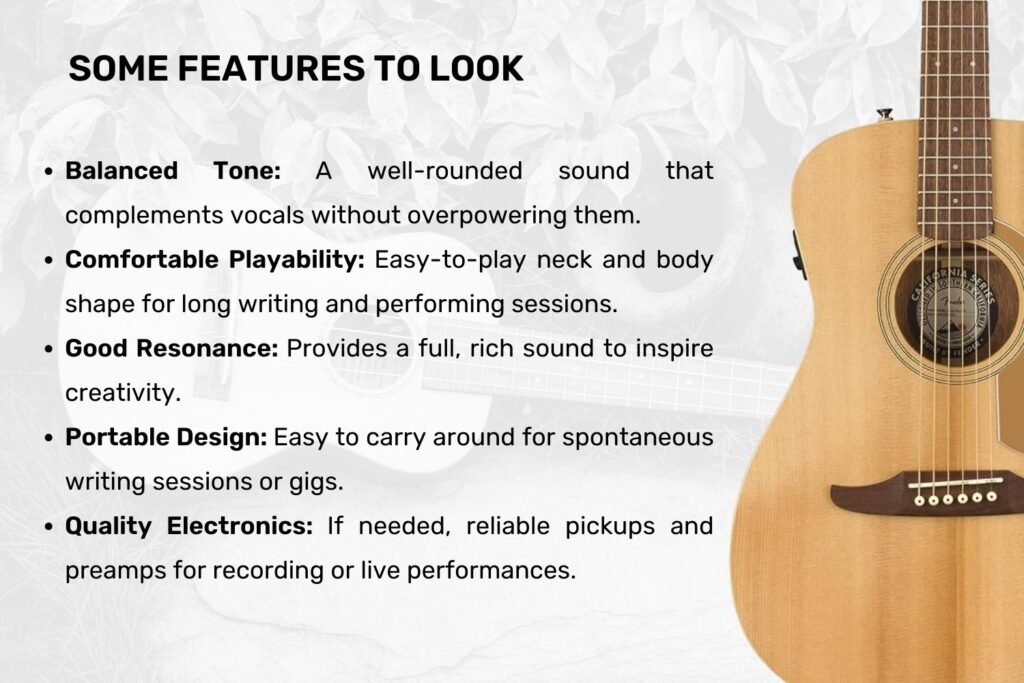
The type of music you plan on playing should also influence your buying decision.
Different styles of music are best suited to certain kinds of guitars.
It’s vital to consider this aspect when shopping for your ideal instrument.
It would be best if you also mulled over the quality and style of the guitar’s construction.
Different brands and lines of guitars are known for their distinctive construction styles that can affect a guitar’s sound, playability, and longevity.
Lastly, consider your level of expertise before investing in a high-end acoustic guitar.
If you’re a beginner, it may be best to start with a less expensive model and upgrade as your skill level progresses.
Don’t forget to factor in the price as well.
It’s essential to establish a budget before shopping and stick to it.
While higher-priced guitars typically offer better quality, plenty of affordable options also provide excellent sound and durability.
The type of wood used in an acoustic guitar significantly impacts the guitar’s tone.
For instance, mahogany is known for its warm and rich sound, whereas spruce provides a brighter and more vibrant tone.
The body shape and design of the guitar also play a significant role.
Dreadnought guitars produce a stronger, more balanced tone, while smaller body styles, such as the grand auditorium, often deliver a softer, more intimate sound.
Another essential feature, often overlooked, is the playability of the guitar.
This refers to the ease and comfort you can play the instrument.
Factors such as action (the distance between the strings and the fretboard), neck width and contour, and string tension can considerably influence how comfortable the guitar is to play.
There are several factors to consider when buying an acoustic guitar.
As stated earlier, things like the type of wood, body shape, and overall guitar construction can significantly impact its sound and playability.
It’s essential to remember these factors to ensure you select a guitar that best suits your musical preferences and playing style.
Furthermore, while the price is an important factor, it should not be the only consideration.
Good guitars come at all price points; a higher price does not always mean a better guitar.
Always test the guitar if possible and research the available brands and models.
This will help you make an informed decision and discover the guitar that’s right for you.
Ultimately, the goal is to purchase an acoustic guitar you love playing.
After examining all factors and making an informed buying decision, the ultimate test is whether or not you love to pick up and play your guitar daily.
How Important is the Type of Wood in an Acoustic Guitar?
When discussing the construction of an acoustic guitar, one cannot overlook the importance of the type of wood used.
Each type of wood contributes to the overall sound, durability, and appearance of the guitar, making it a vital factor to consider.
Sound quality is significantly impacted by the wood type as different woods produce different tones.

For instance, Mahogany is known for its ability to generate a warm, resonant sound that is ideal for bluesy tones.
Meanwhile, Spruce, a common choice for top plates, is appreciated for its crisp and clear tone, making it a popular choice among many singer-songwriters.
In contrast, Cedar offers a softer tone and is very responsive, making it perfect for fingerstyle players.
The type of wood also affects the guitar’s durability.
Guitars made from harder woods such as Maple are usually more resistant to wear and tear.
On the other hand, softer woods like Cedar might require more care and handling due to their susceptibility to dents and scratches.
The appearance of the guitar is another factor influenced by the type of wood.
Woods like Rosewood and Koa are highly sought after for their visually stunning grain patterns and colors.
However, a beautiful-looking guitar doesn’t always equate to superb sound quality, so a balance between aesthetics and tonal properties should be sought.
Furthermore, it’s also important to consider that the quality of the wood used in the guitar’s construction plays a critical role.
A guitar constructed from high-quality, well-cured wood will invariably produce a better sound than one made from cheap wood or even good wood that hasn’t been properly dried and seasoned.
This is why it’s so important to purchase from a reputable brand or luthier experienced in selecting and treating guitar woods properly.
In the end, the best wood choice will depend on a combination of the guitar’s intended musical genre, playing style, personal preference, and budget.
The specific tonal characteristics, durability, and visual appeal of certain woods might align with what a singer-songwriter is looking for in their ideal acoustic guitar.
However, it’s important that each individual plays different guitars with varying wood types to understand the nuances and find what speaks to their musical style and sound.
Remember that your ears and hands are the best judges of the right guitar for you, and the wood type is only one element in the vast world of guitar characteristics that make each instrument unique.
What is the Significance of Body Shape in Acoustic Guitars?
The shape of an acoustic guitar has a profound and often unrecognized impact on the sound quality and overall performance of the instrument.
One of the primary reasons for this is that the shape largely determines the resonance and the tone of the guitar.
Resonance is the quality that allows the guitar’s sound to ring out and echo, and it is largely determined by how the air within the guitar’s body vibrates.

The larger the body of the guitar, the more this effect is present.
However, the shape of the guitar also influences the comfort and playability of the instrument.
A smaller, more compact shape may be comfortable for some players, but it could hinder the resonance and fullness of the sound.
On the other hand, a larger body shape can produce a richer, more resonant sound, but may not be as comfortable for some players to hold and play.
The dreadnought body shape, for instance, is known for its bold and powerful sound, making it an excellent choice for singer-songwriters who need their guitar to fill out their sound and stand out in a mix.
Grand Auditorium guitars, on the other hand, tend to provide a more balanced tone that does equally well in strumming and fingerpicking, making them a versatile choice for singer-songwriters.
Yet another important point is the projection of the guitar’s sound.
Projection determines how well the guitar’s sound carries, which can be crucial for singer-songwriters performing in larger venues.
Furthermore, the shape of the guitar can have a surprising impact on the tone produced by the guitar.
Each shape accentuates certain tonal characteristics which, when combined with the player’s technique and style, can create a unique sonic signature.
This can play an instrumental role in defining the tone of a singer-songwriter’s performance and differentiating it from others.
Lastly, it’s also worth noting that many singer-songwriters find their aesthetic inspiration from the visual appeal of the guitar’s shape.
In addition to the sound and playability, the overall shape and look of a guitar can be a powerful part of a performer’s onstage persona and presentation.
To put it simply, the shape of the acoustic guitar is not just a matter of aesthetics or comfort.
It plays a critical role in defining the sound, resonance, and overall performance qualities of an acoustic guitar, making it an essential consideration for any singer-songwriter.
How Does String Material Impact the Sound of an Acoustic Guitar?
The most widely used materials are bronze, phosphor bronze, and silk & steel.
Bronze strings, composed of copper and zinc, are known for their bright and clear sound; they are an ideal choice for various music genres.
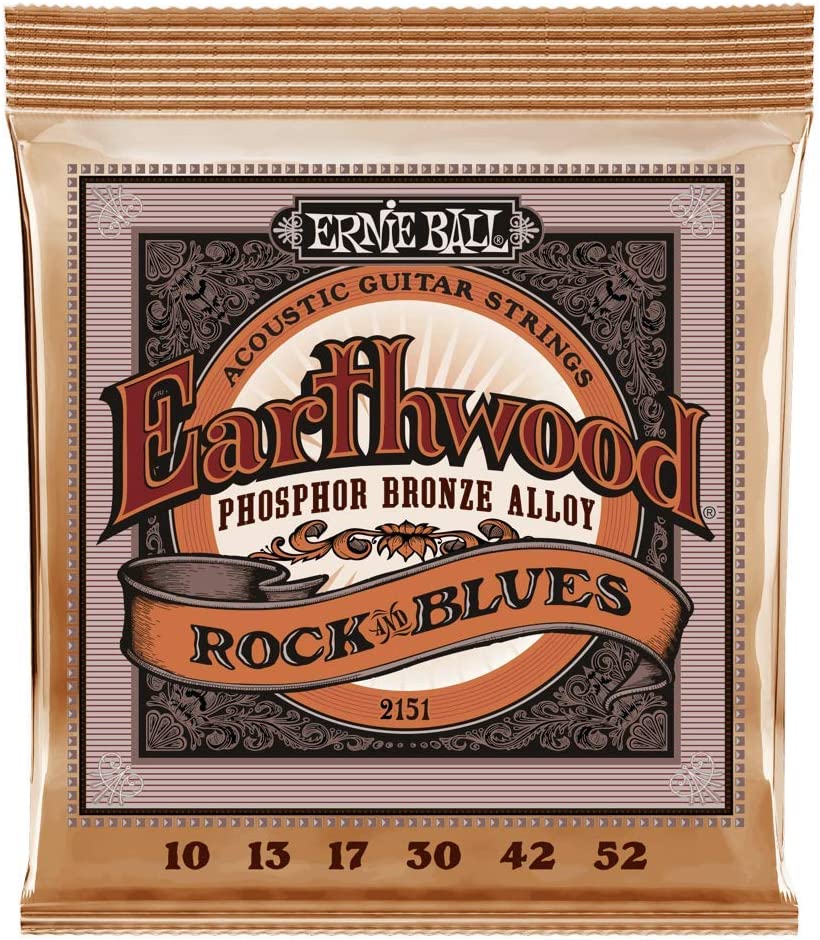
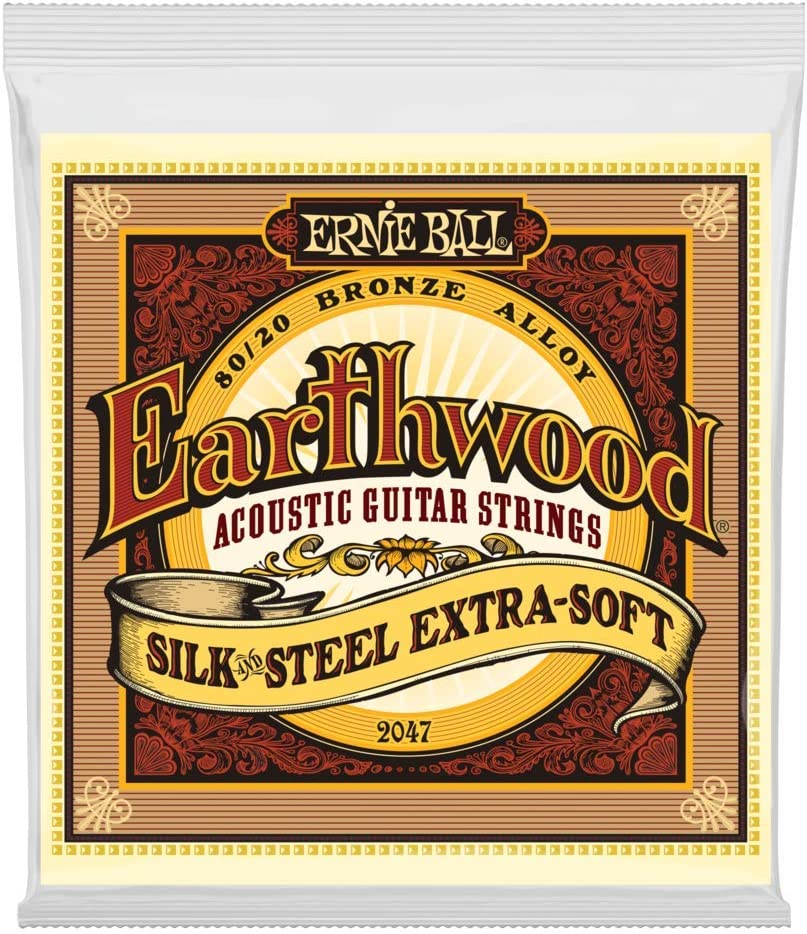
Conversely, Phosphor Bronze strings are slightly more subdued and warmer; they offer a more balanced, full-bodied tone suitable for a wide range of music.
Silk & Steel strings, as the name suggests, are a combination of silver-plated copper wire wrapped around a silk, nylon, or steel core, producing a soft and gentle tone; they are popular among folk musicians.
Lighter strings are easier to play as they exert less tension on the guitar’s neck, but they offer a more narrow dynamic range and less sustaining power.
Roundwound strings, the most common type, offer a brighter tone and additional sustain, but they can lead to more finger noise and faster fret wear due to their textured surface.
In contrast, flatwound strings have a smooth surface, reducing finger noise and fret wear, but they produce a darker and more muted tone.
Understanding how different string materials and techniques impact the sound can help singer-songwriters choose the best acoustic guitar for their specific musical requirements and style.
Experimenting with different string types can allow musicians to find the one that resonates most with their musical voice, definig their unique sound.
By carefully considering these elements, singer-songwriters can uncover the best acoustic guitar that allows their creativity and talent to shine through the most compellingly.
In the end, the impact of the string material on the acoustic guitar’s sound is just one piece of the puzzle; nonetheless, it is an equally essential piece to be considered to further accentuate the power and expression of the music they create.
Which Brands Are Known for Quality Acoustic Guitars?
When looking for a quality acoustic guitar, several iconic brands come to mind globally.
Martin & Co, more commonly known as Martin, has a reputable name that has been built over the years through providing acoustic guitars with excellent build quality and superior sound.
Their instruments have been trusted by world-renowned musicians which has significantly contributed to their widely recognized status.
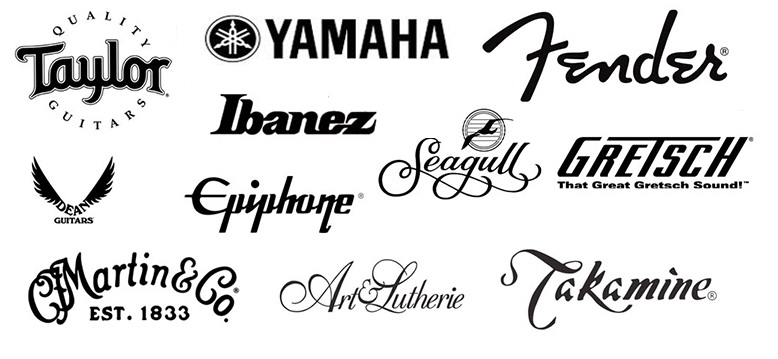
Gibson is yet another brand that has made a lasting impact in the music industry.
Highly favored by blues and rock artists, Gibson’s acoustic guitars are renowned for their rich and full-bodied sound qualities.
Their models like the J-45 and Hummingbird remain all-time favorites among musicians of all genres.
Located in California, Taylor Guitars has cemented its name in the guitar-making industry in a relatively short time.
Appealing to a wide demographic of guitarists, Taylor’s acoustic guitars stand out for their easy playability, modern aesthetics, and consistent quality.
The brand’s commitment to sustainability is also a key factor contributing to its increasing popularity among ethically minded musicians.
Established in Japan, Yamaha is known for producing acoustic guitars that offer excellent value for money.
Their guitars are versatile and well-constructed, making them suitable for both beginners and experienced players alike who need quality at an affordable price.
Meanwhile, Fender – initially known for their electric guitars – has been also producing impressive acoustic guitars.
Their guitars have a distinctive sound and are built to the high standards that musicians have come to expect from the Fender brand.
Finally, Seagull, a Canadian company, produces hand-crafted acoustic guitars that are highly esteemed by discerning musicians for their unique tone, impressive build quality, and sustainably harvested wood.
Their guitars distinguish themselves through their impeccable craftsmanship and innovative design.
It is important to note that while these brands are reputed for their quality, the ultimate decision should be based on the individual guitarist’s preference.
Each brand offers a unique sound, feel, and playing experience, thus what might be the perfect acoustic guitar for one musician might not necessarily be the ultimate choice for another.
Therefore, it is recommended to try out different brands and models to find the guitar that truly suits one’s playstyle and sonic signature.
Choosing a quality brand is vital, but it’s equally crucial to remember that the value of a guitar extends beyond the label on its headstock.
Understanding your own musical requirements, personal comfort, and budget are ultimately the factors that will guide you in making the best decision.
How Do You Care for an Acoustic Guitar?
Acquiring an acoustic guitar is undeniably a big commitment, not just financially but also in terms of maintaining the instrument.
Caring for your guitar extends the lifespan and ensures it continues delivering excellent sound.
Several factors are involved in maintaining an acoustic guitar, from handling, cleaning, to storage.
Handling your acoustic guitar correctly is one of the most crucial aspects of guitar care.
Avoiding scratches or dents will also ensure the longevity of your guitar.
Never place your guitar on rough surfaces, and remember to always use a stand to avoid any accidental falls.
Keeping your guitar clean is another essential factor in ensuring its good performance over time.
Whether it’s fingerprints, dust, or sweat, it’s crucial to clean your guitar regularly.
A clean, dry cloth should be enough for daily cleaning, while for deeper cleaning, you may need to use guitar cleaning solutions.
Moreover, changing the guitar strings frequently not only enhances the sound quality but can also prevent potential damage.
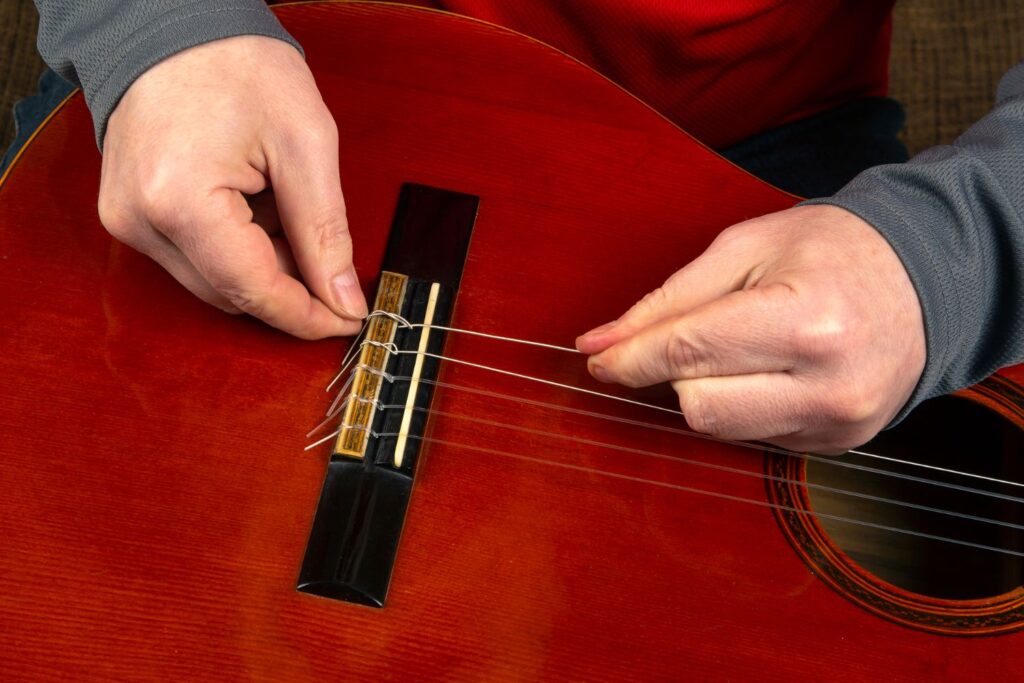
Remember, old or rusty strings not only sound bad but can also harm the fretboard.
Frequent tuning of your guitar is another critical aspect of guitar care.
Out-of-tune guitars not only sound wrong but can also cause string tension that may damage the neck.
Soundboard and body should also be inspected regularly for any signs of wear and tear or damage.
Humidity can also greatly impact the acoustic guitar, so it’s essential to keep the instrument in an appropriate environment.
Investing in a guitar case with a humidifier can help maintain the wooden parts of the guitar.
The place where you store your guitar also determines the longevity of your instrument.
Keeping your guitar in a case when not using it can help in maintaining its overall state.
Store it in a place where it’s not exposed to direct sunlight or near to a heat source, both can cause serious damage to the wood.
Finally, getting your guitar professionally set-up from time to time can make a significant difference in the performance and lifespan of your guitar.
Singer-songwriters who truly invest time and effort in caring for their acoustic guitars can expect a rewarding play and creative experience.
With proper care, the 15 best acoustic guitars for singer-songwriters can be a worthy investment in their musical journey.
Remember, a well-maintained acoustic guitar not only sounds better but lasts longer, giving you more value for your money and a better musical experience.
What Are the Pros and Cons of a Cutaway Design?
When discussing the design of an acoustic guitar, the cutaway feature is one of the elements that warrants detailed examination.
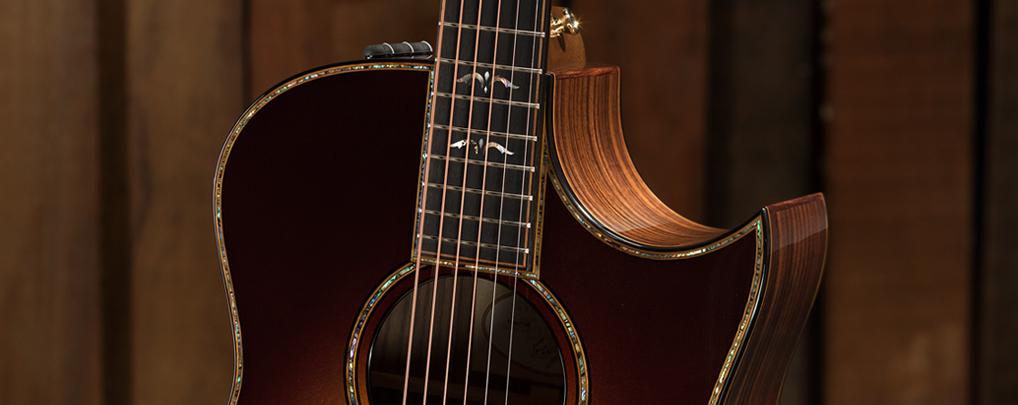
Cutaway designs are an innovative feature that gives the guitar not only a unique aesthetic look but adds a functional aspect as well.
From a visual standpoint, a cutaway guitar has a scooped indentation in its body, around the neck area.
It’s often seen in the upper bout of the body, which is the half of the guitar’s body on the side of the strings that the player frets.
The creation of the cutaway was driven by a need to provide easier access to the frets higher on the neck.
It essentially allows the player’s dominant hand to reach the higher frets more comfortably, which can enable a broader range of notes.
The real conundrum lies not in its design, but in understanding the pros and cons of using a cutaway in an acoustic guitar.
On the positive side, the essential and most significant benefit is it enables the player to reach higher notes more easily.
This means that if you are a guitar player keen on exploring the higher register of the melody, a guitar with a cutaway could offer you a noticeable advantage.
Particularly for singer-songwriters, this feature could be immensely beneficial as it facilitates greater experimentation with sounds and compositions.
Having a cutaway might also allow you to use certain playing techniques that may not be possible or highly challenging on a non-cutaway model.
However, the cutaway design has had its fair share of critics who argue it’s more of a nuisance than a benefit.
From the perspective of these critics, the biggest downside is the perceived loss of resonance in the guitar’s sound.
Some guitar enthusiasts believe that the cutaway design can disrupt the sound distribution within the resonating chamber of the guitar’s body.
This has led some to argue that a cutaway guitar lacks the full-bodied tone of a guitar without this feature.
Sound quality is subjective and can vary greatly depending on individual tastes and preferences.
Ultimately, the decision of whether to choose a cutaway design should be based upon your personal playing style and sound preference.
One advantage that cannot be contested is that cutaways add a unique visual touch to any acoustic guitar.
Since the cutaway enhances the guitar’s visual appeal, it could be an important consideration for performers who rely on aesthetics as part of their onstage persona.
The convenience of easier access versus the possibility of compromised sound is a tug-of-war debate that continues amongst guitar enthusiasts.
Whatever be your take, it’s important to remember that the cutaway is merely a feature and not a dictating factor for a guitar’s overall sound quality or playability.
The ultimate assessment of its value and consequence is largely down to personal preference.
Considering every aspect of the cutaway debate will lead you to a more informed decision on whether it’s the right choice for your individual needs as a singer-songwriter.
Should You Consider an Acoustic Electric Guitar?
The world of guitars is rich and diverse, with myriad options to choose from.
One such option is the acoustic electric guitar, a versatile instrument that can offer the best of both worlds.
At its core, an acoustic electric guitar is an acoustic guitar outfitted with an electronic pickup system. This enables the guitar to be plugged into an amplifier or a sound system, giving you the option to play it as an electric guitar.
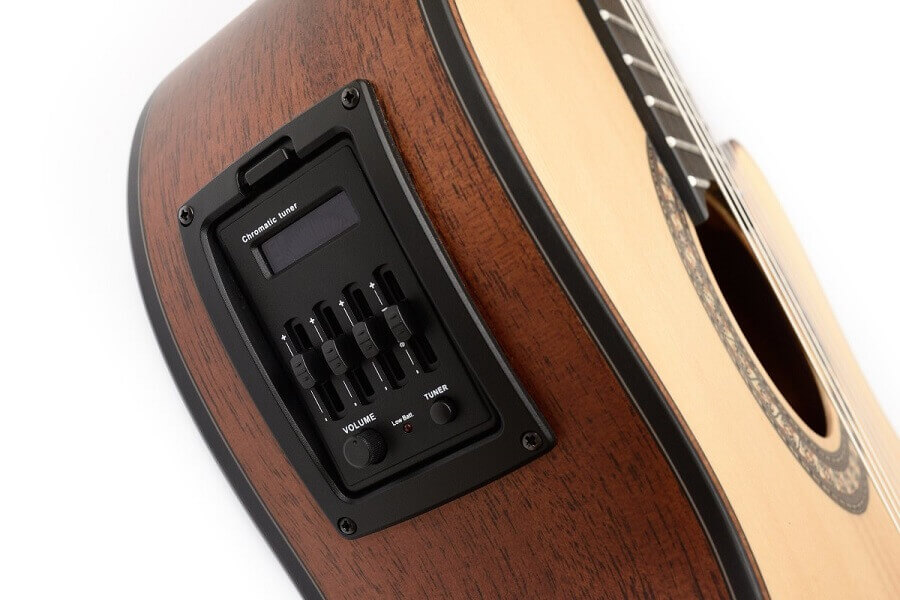
There is no denying the pull of the electric guitar with its ability to produce a range of powerful, distorted sounds, but it’s equally undeniable that the acoustic guitar holds its own allure.
The acoustic guitar, with its natural, resonant tone, is a staple in many musical genres, particularly folk, country, and singer-songwriter music.
The question then arises – should a singer-songwriter consider using an acoustic electric guitar?
That depends on various factors, including the style of music you play, your performance needs, and your personal preferences.
If your music relies heavily on the raw, unadulterated sound of the acoustic guitar, you might prefer sticking to a traditional acoustic.
However, if your musical style incorporates elements of genres that utilize electric sounds, such as rock, blues, or jazz, an acoustic-electric might serve you well.
Acoustic-electric guitars also offer greater flexibility in performance settings.
If you’re playing in large venues or with a full band, the ability to plug into an amplifier or sound system can ensure your guitar sound cuts through the mix and reaches your audience.
Moreover, most acoustic-electric guitars come equipped with onboard preamps that offer tone shaping options, allowing you to tweak your sound to your liking.
On the flip side, some players find that the electronic components in an acoustic-electric guitar can alter the natural resonance of the instrument.
While technology has come a long way in minimizing this issue, if you’re a purist, this might be a point of consideration.
Then, there’s the aspect of cost.
Acoustic-electric guitars tend to be pricier than their purely acoustic counterparts as they incorporate additional technology.
However, there are affordable options available in the market that don’t skimp on quality.
In summary, whether or not you should consider an acoustic-electric guitar largely boils down to your individual needs and preferences.
Experiment with different guitars, make note of what draws you in, and ultimately, choose an instrument that inspires you to create and perform your music.
How to Resolve Common Acoustic Guitar Issues?
Like any other instrument, acoustic guitars are susceptible to a number of common issues, many of which can be resolved with some knowledge and proper care.
The first challenge that might come up with an acoustic guitar is keeping it in tune.
Maintaining proper tuning is integral for the performance of the guitar and can be influenced by a variety of factors such as the condition of the strings, the humidity or temperature, and the condition of the guitar’s tuners.
Replacing worn or old strings, ensuring your guitar is stored properly and periodically checking the tightness of the tuner screws can greatly minimize tuning issues.
Another common issue arises from fret buzz, which is a buzzing noise that occurs when a string vibrates against one or more of the guitar’s frets.
This problem is usually caused by low action (the distance between the strings and the fretboard), or by uneven frets.
Resolving this can involve adjusting the guitar’s action, smoothing or replacing the frets, or sometimes making adjustments to the neck alignment.
A crack or dent in an acoustic guitar can not only damage its aesthetic appeal, but also potentially impact its sound quality.
Small cracks or dents can often be repaired at home using wood filler or a similar product, but larger damage may require professional repair.
Bridges and nuts can also become loose or worn over time, which can lead to a variety of problems, including tuning instability and poor intonation.
These can often be fixed by tightening or replacing the component.
A common issue that affects the cleanliness and longevity of the guitar is the accumulation of dirt and oil from fingers on the fingerboard and strings.
Regular cleaning with a suitable guitar cleaning product can help prevent build-up and maintain the life and playability of the guitar.
Poor intonation is another common issue with acoustic guitars.
This refers to the accuracy of a guitar’s pitch across its entire fretboard and can result in the guitar sounding out of tune at higher frets even if it’s in tune at the open string.
Resolving this issue can involve adjusting the guitar’s saddle, making modifications to the frets, or in some cases replacing the guitar’s nut or bridge.
In addition, problems can also arise from internal factors such as issues with the truss rod, a metal rod inside the neck of the guitar which helps control the neck’s relief, or curvature.
Adjusting the truss rod of a guitar is something that should generally be done by a professional, as improper adjustment can lead to serious and potentially permanent damage to the guitar’s neck.
With all these potential issues in mind, it’s clear that good maintenance and care are crucial to the longevity and performance of an acoustic guitar.
While many smaller issues can be resolved at home with a basic understanding of the instrument and some basic tools, serious problems or larger adjustments should always be undertaken by a professional to ensure the continued health and playability of the instrument.
What Skills Are Important for Playing Acoustic Guitar?
When considering the skills necessary for playing the acoustic guitar, the first thing that comes to mind is commitment and consistency.
Like any new skill, mastering the acoustic guitar requires regular and disciplined practice.
But beyond willingness and tenacity, there are certain technical skills and knowledge that can greatly aid in your guitar playing journey.
One of these is understanding the concept of musical notes and chords.
Learning to read guitar tabs and musical notation is crucial in order to play songs and improve over time.
Another important skill for acoustic guitarists is developing coordination between both hands.
Your left hand will be responsible for fretting notes on the fingerboard, while your right hand will be in charge of strumming or picking the strings.
Learning how to synchronize these actions smoothly is key to playing fluidly and rhythmically.
Another crucial ability involves building finger strength and dexterity.
Playing the guitar often requires holding down several strings at once, which calls for significant finger strength especially on an acoustic guitar where the strings are generally thicker than those on electric guitars.
One aspect sometimes overlooked in learning to play the acoustic guitar is developing a good sense of rhythm.
Having a feel for timing will help you change chords on the beat, keep pace with the music as well as contribute to a more loaded performance when playing in a group setting.
Finally, it’s essential to cultivate listening skills.
Being able to ear train will help you to recognize chords and melody lines in other songs, enabling you to replicate them or even compose your own.
These are by no means all the skills required to play the acoustic guitar, but they provide a solid foundational starting point.
Whether you are picking up the guitar to accompany your singing, to write songs, or simply for the love of the instrument, remember that the key to mastery is patience and persistence.
The Bottom Line
After discussing a range of options, we’ve determined that the best acoustic guitars for singer-songwriters are those which combine high quality sound, playability, and durability.
These guitars not only bring out the best in your music, but also inspire you to create and perform even more.
Whether you’re just starting out or you’ve been writing for years, investing in a top-notch acoustic guitar can truly make a world of difference.
Remember, the right guitar can be a lifelong companion in your musical journey.
So choose wisely, invest in quality, and let your music express who you truly are.
Sources: sweetwater.com ; guitarcenter.com ; chicagomusicexchange.com ; theacousticguitarist.com

More than 10 years of experience playing and writing about guitars! When not writing, I can be found strumming away some Johnny Cash tunes. Favorite all time guitar is the Gibson Les Paul. #TeamGibson




